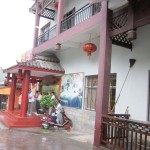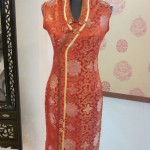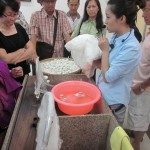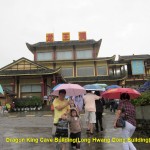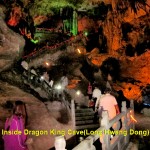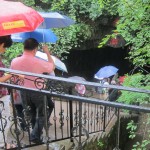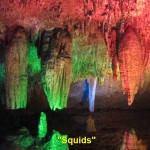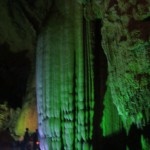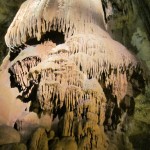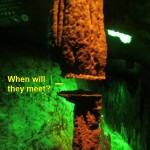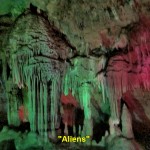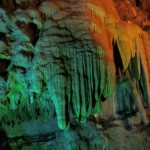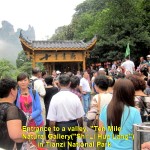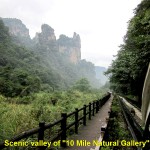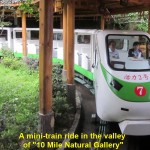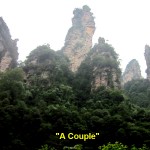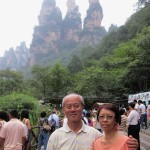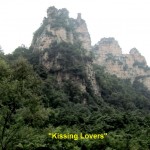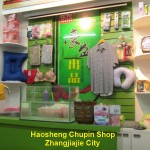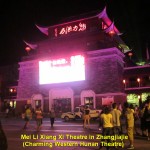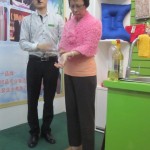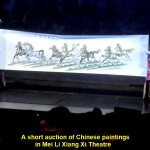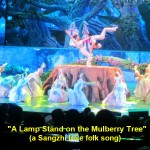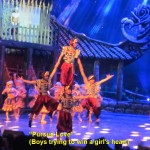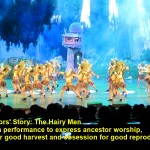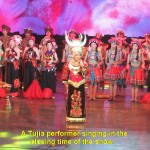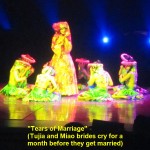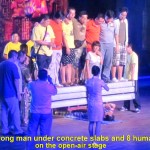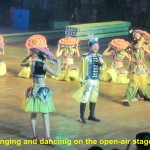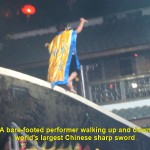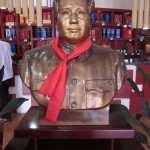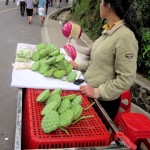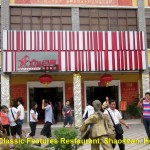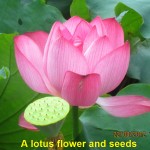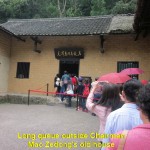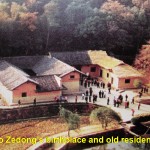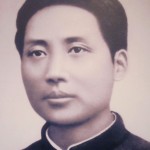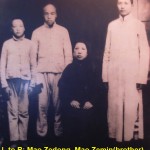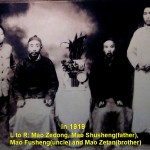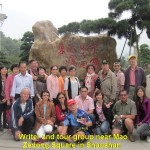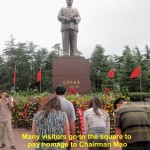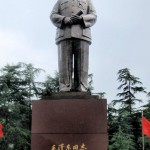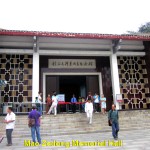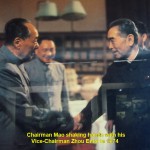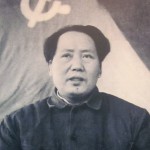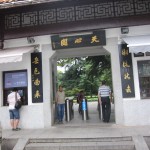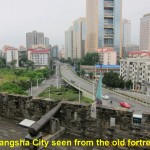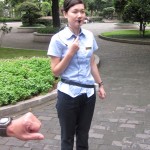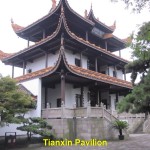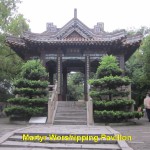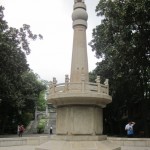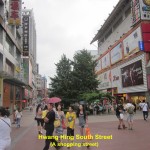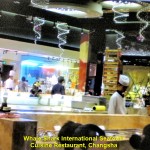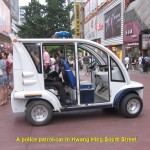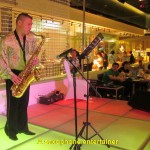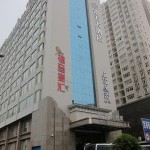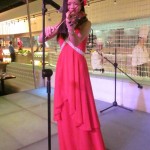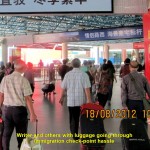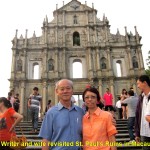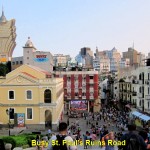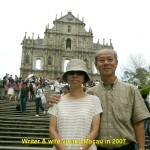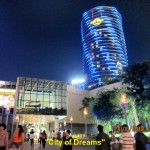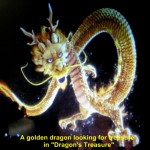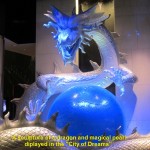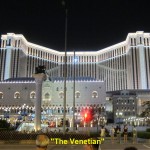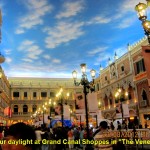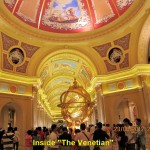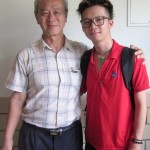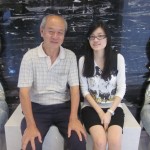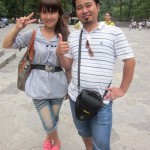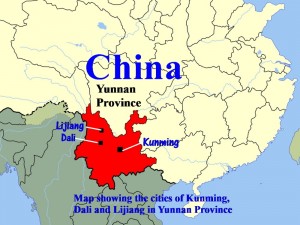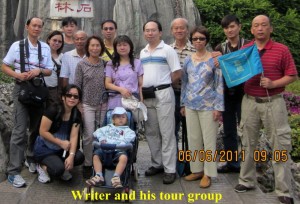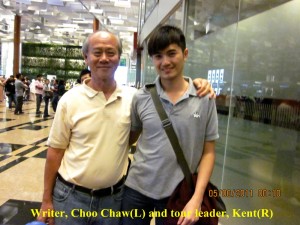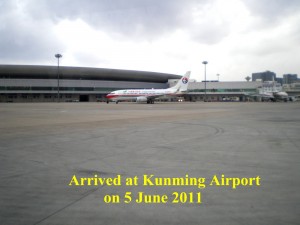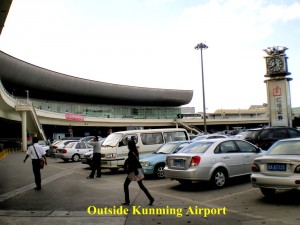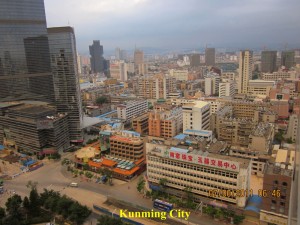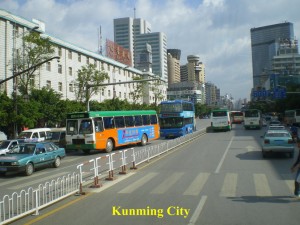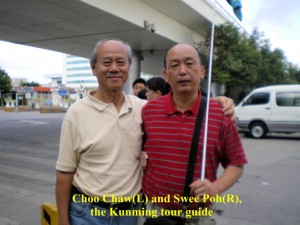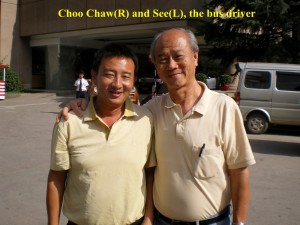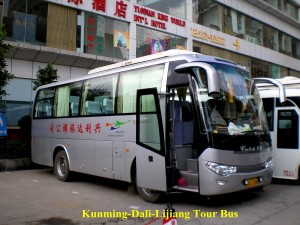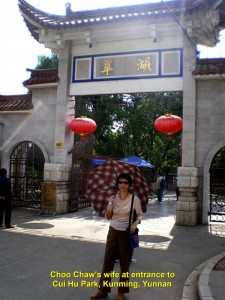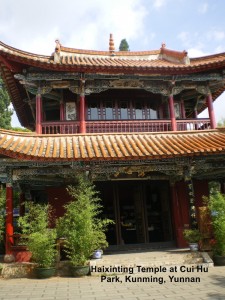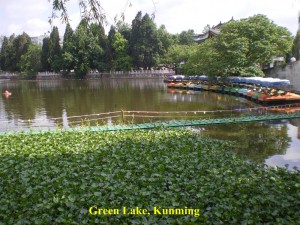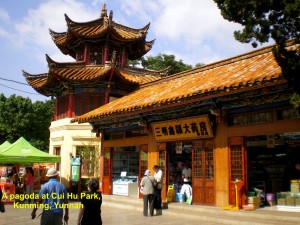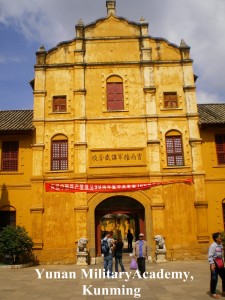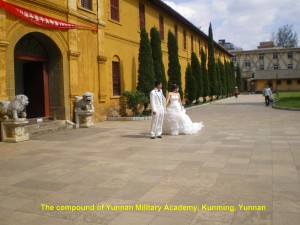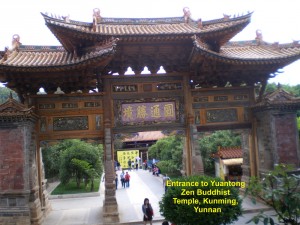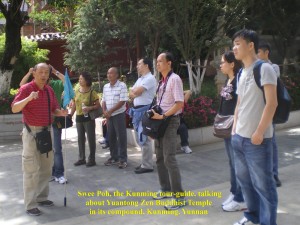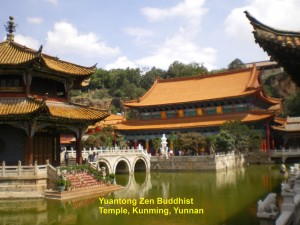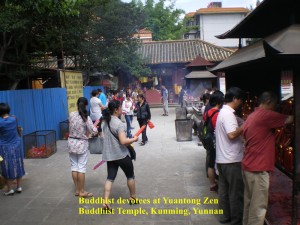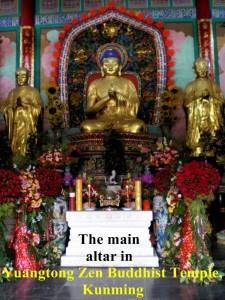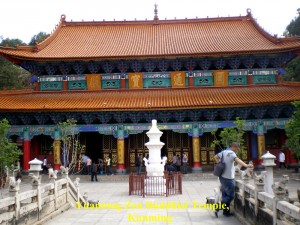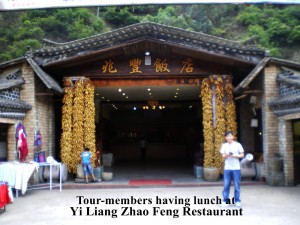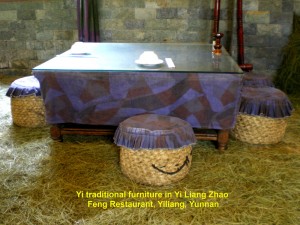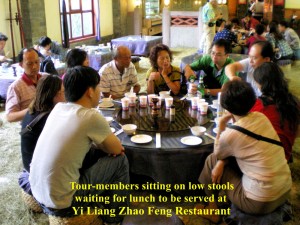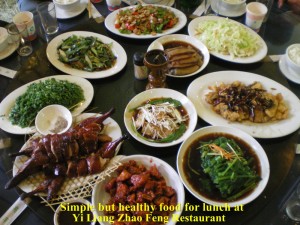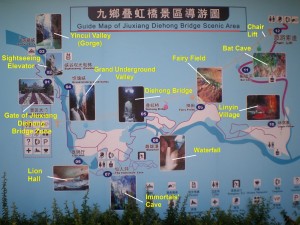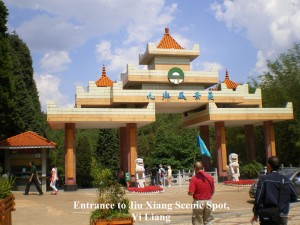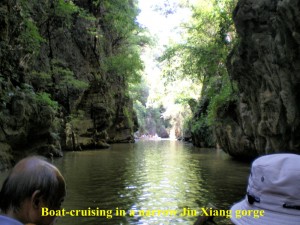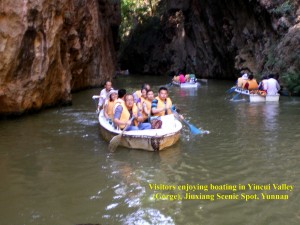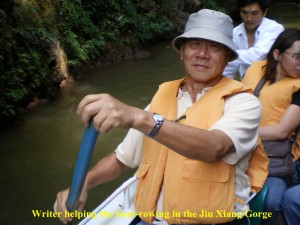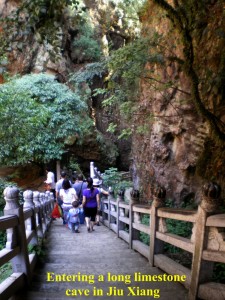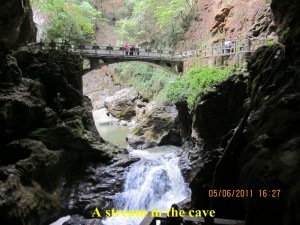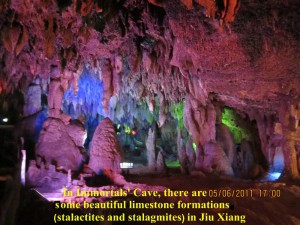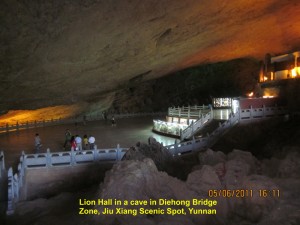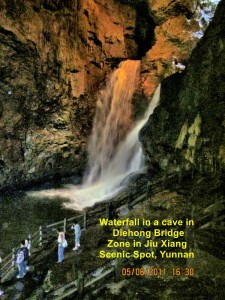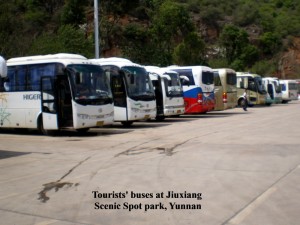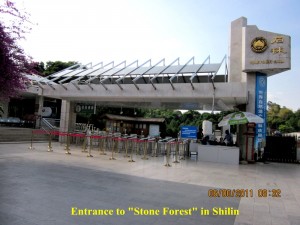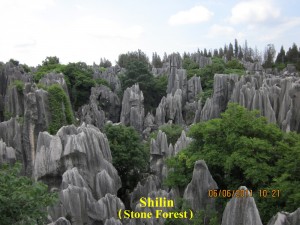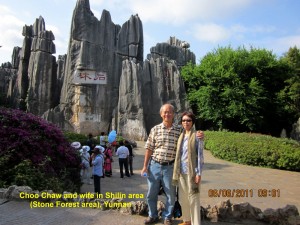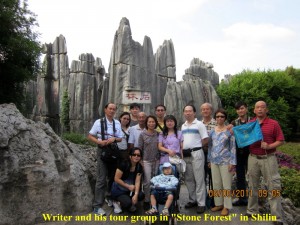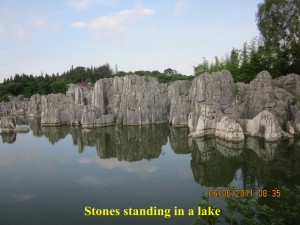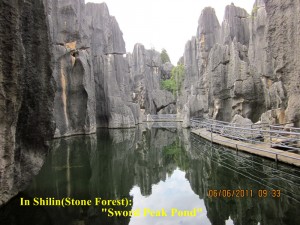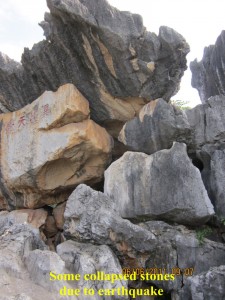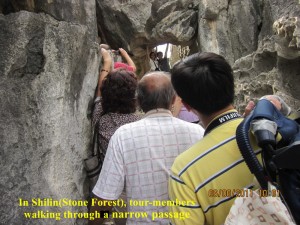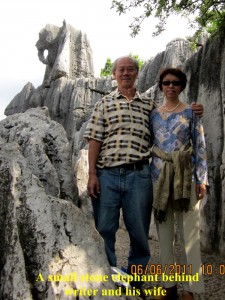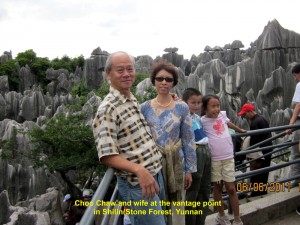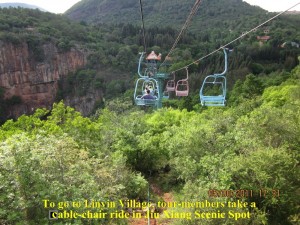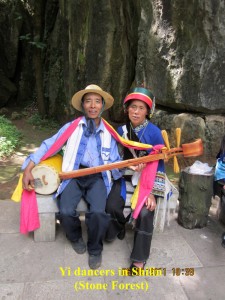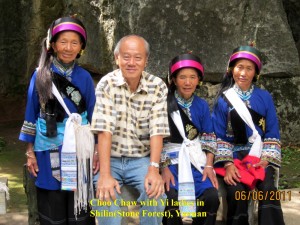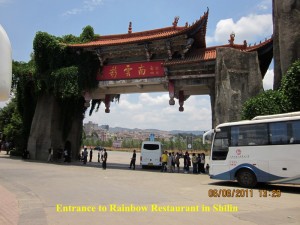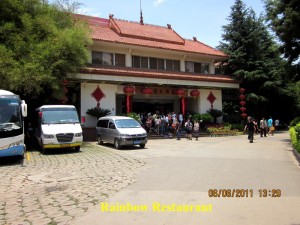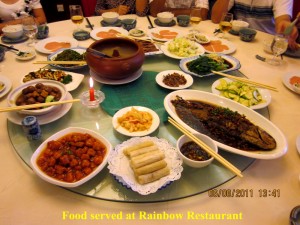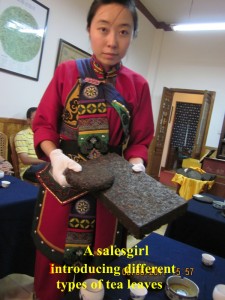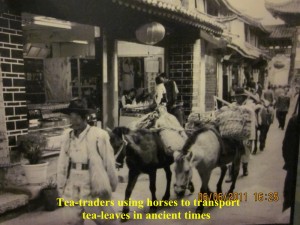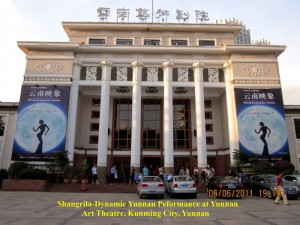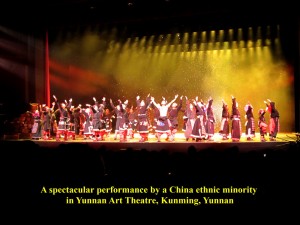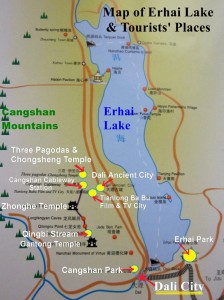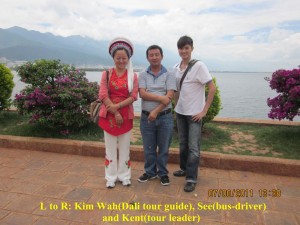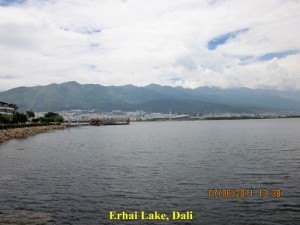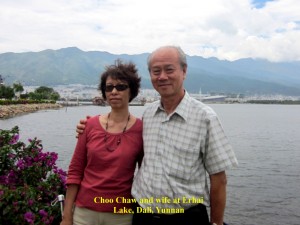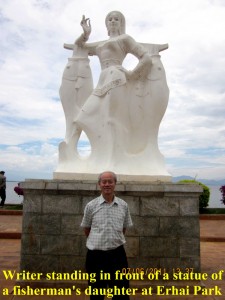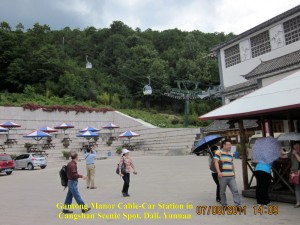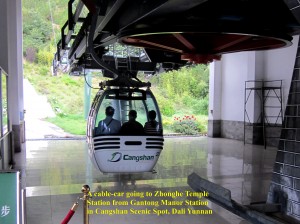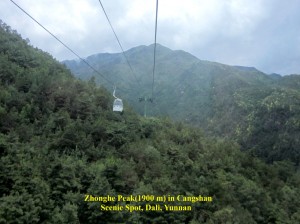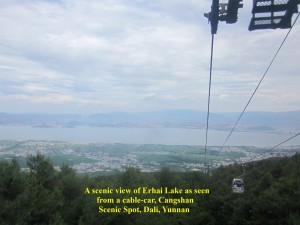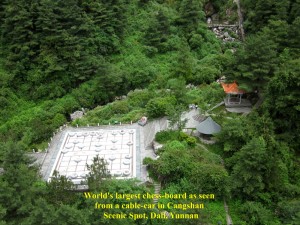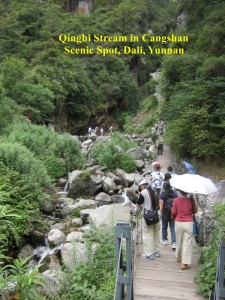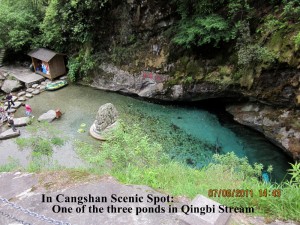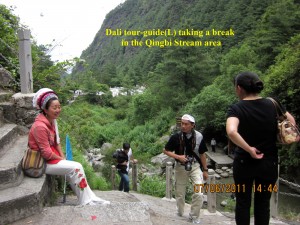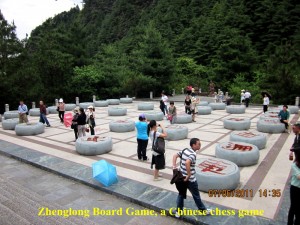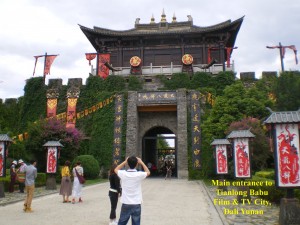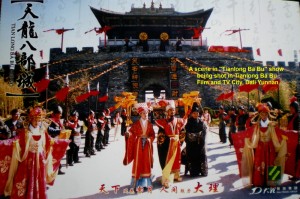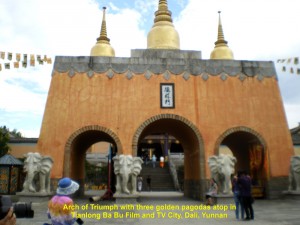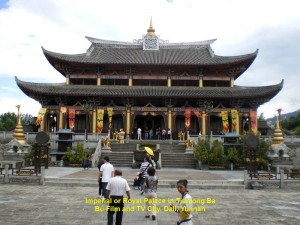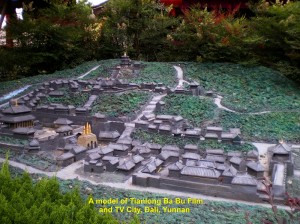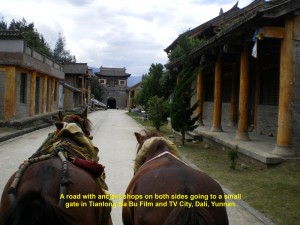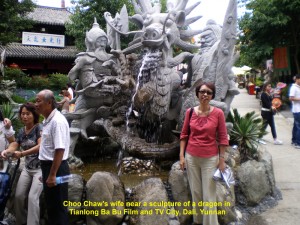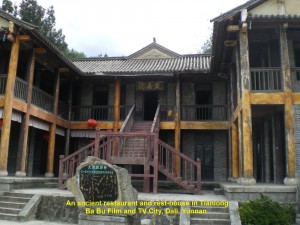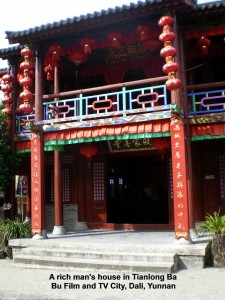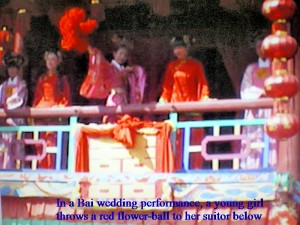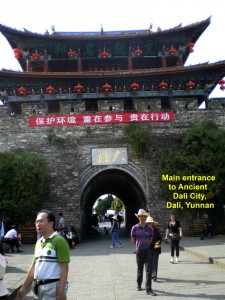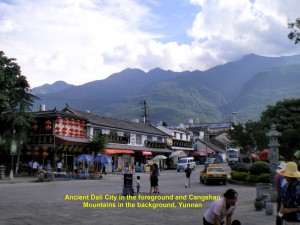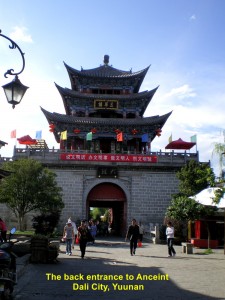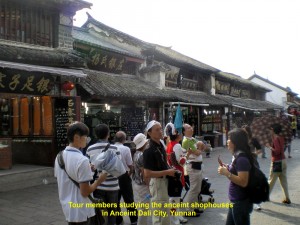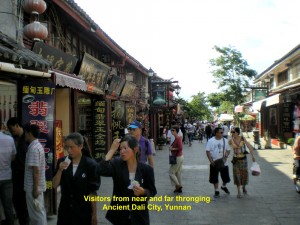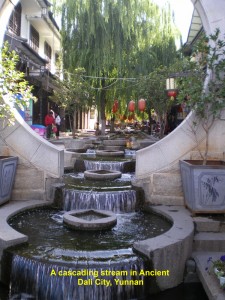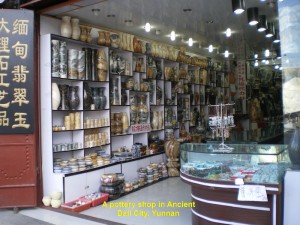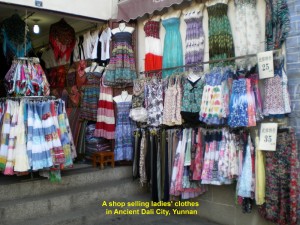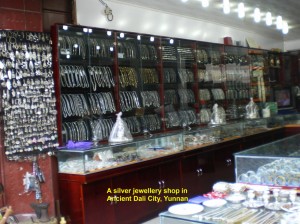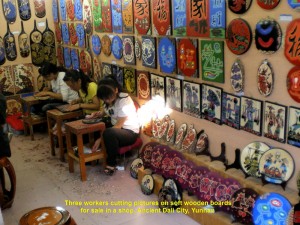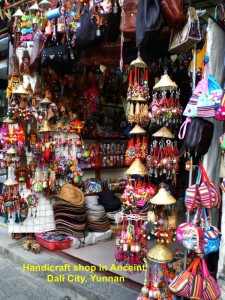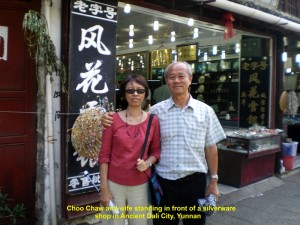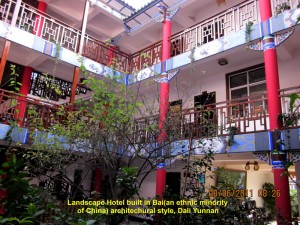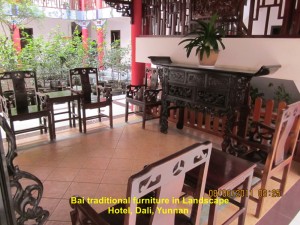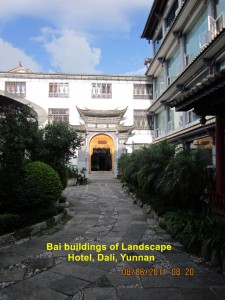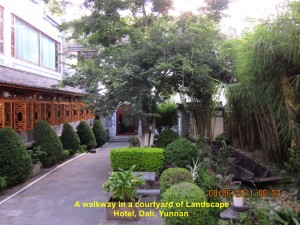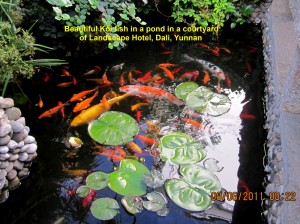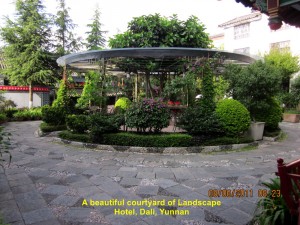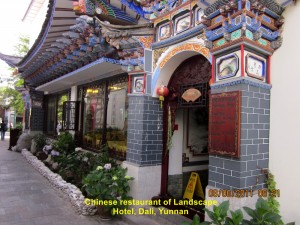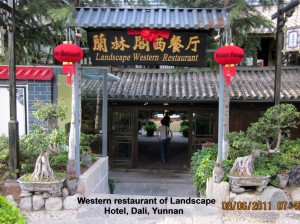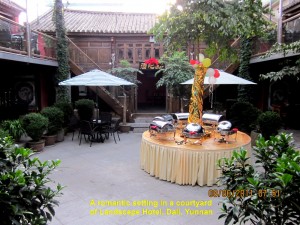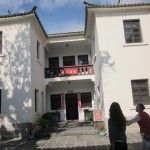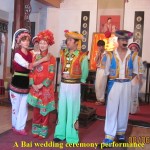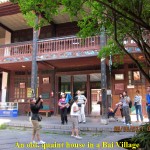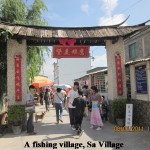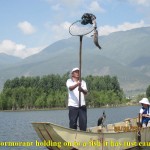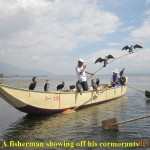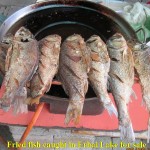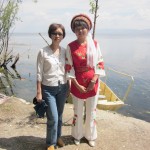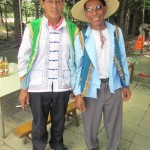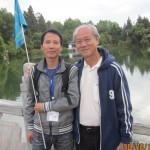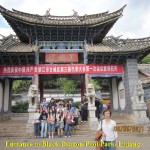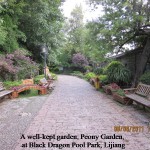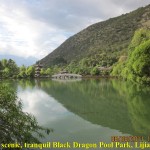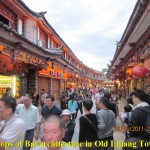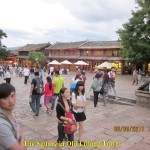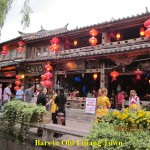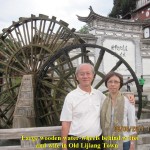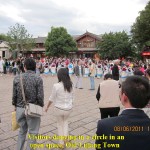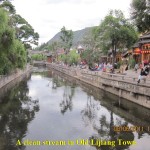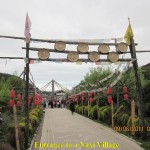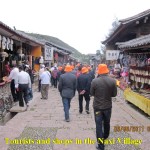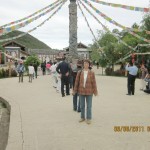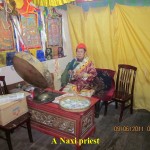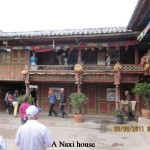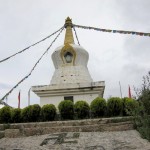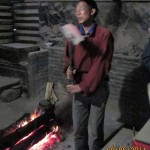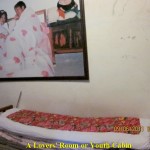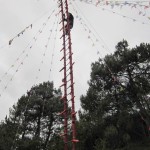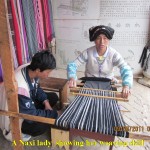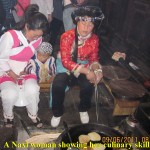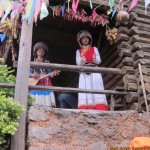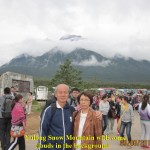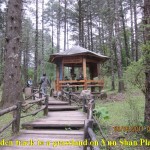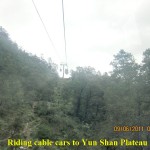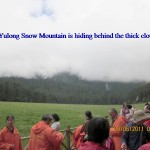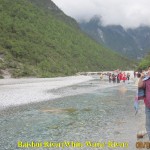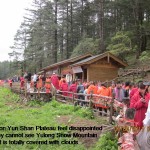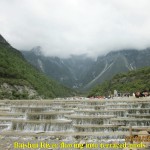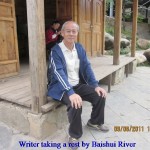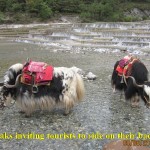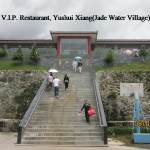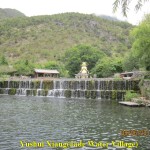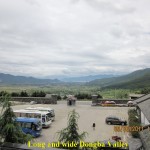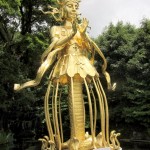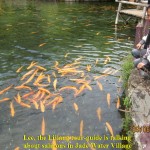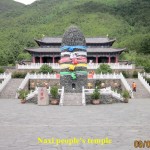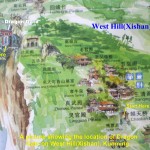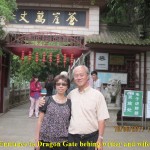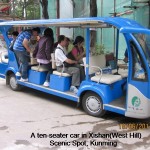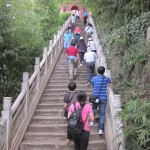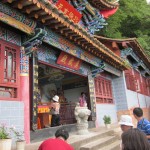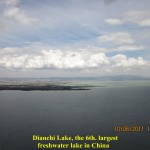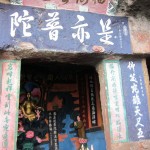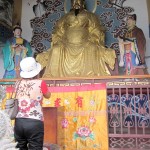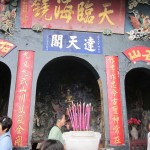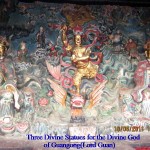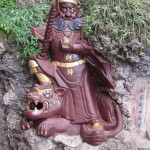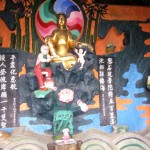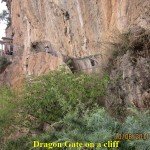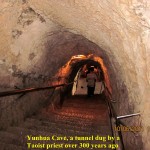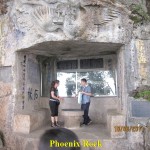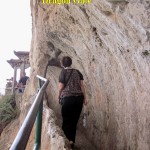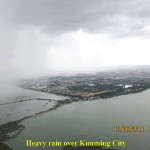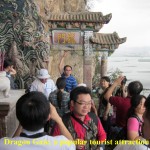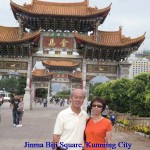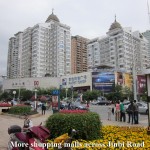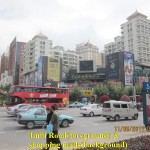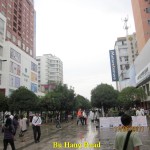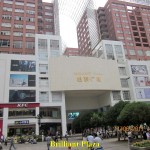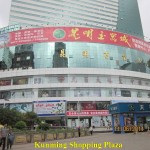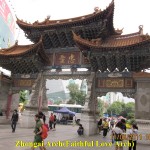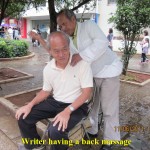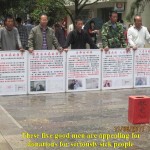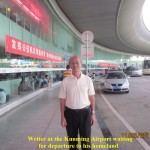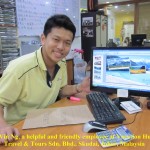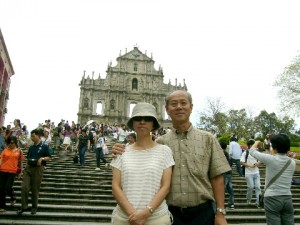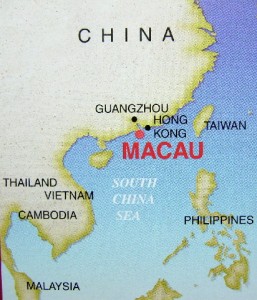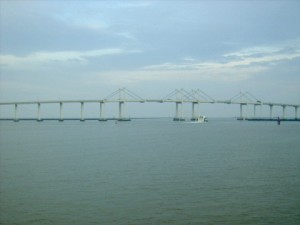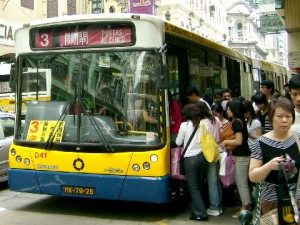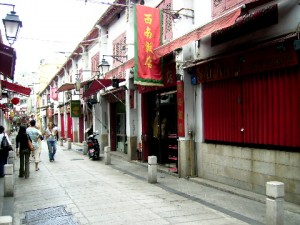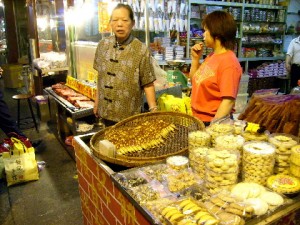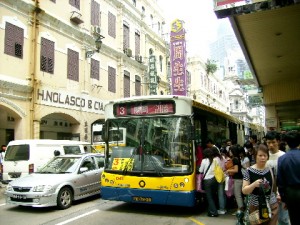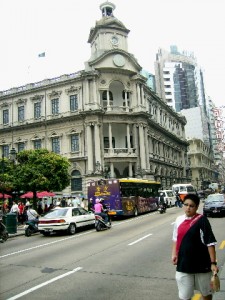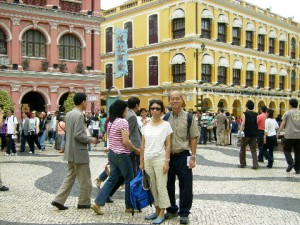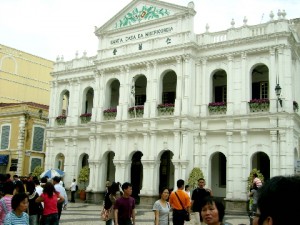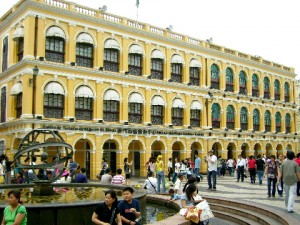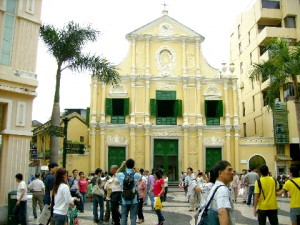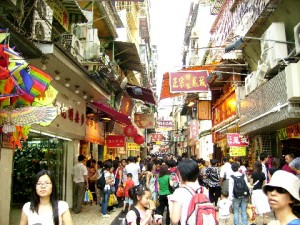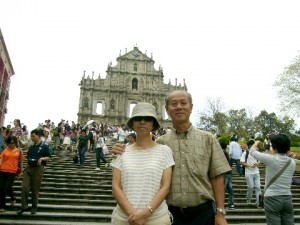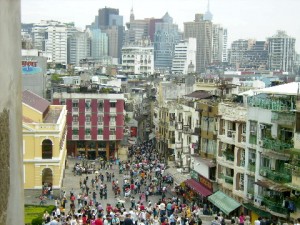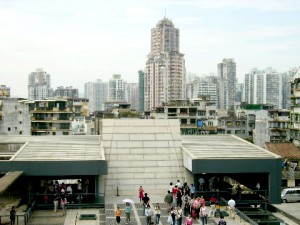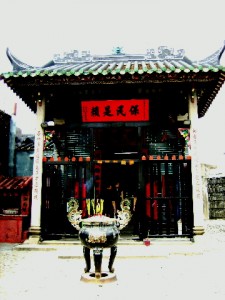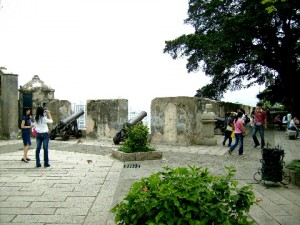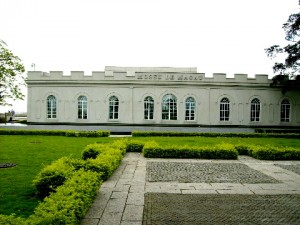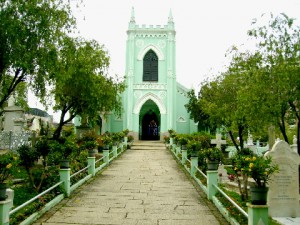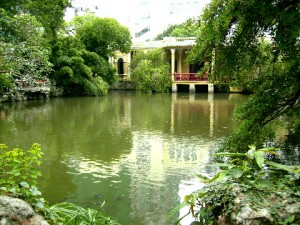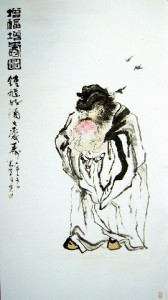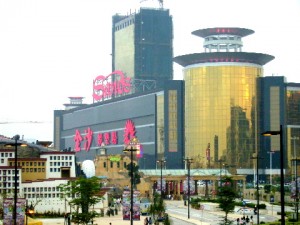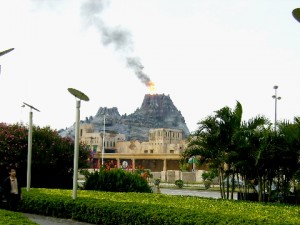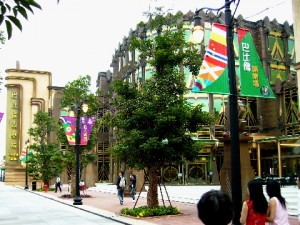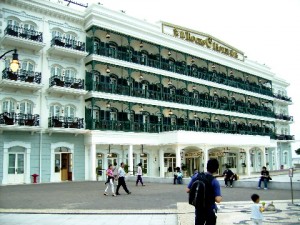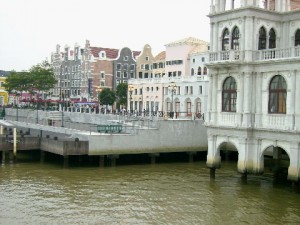Zhangjiajie Travel II
(continue from Zhangjiajie Travel I)
Zhangjiajie Travel II
Day 4 Tuesday 21 August 2012
Silk Product Shop
In the morning, we visited a silk shop in the city. At the shop, we learned about silkworms making cocoons which were then used for making silk cloth and blankets. After that educational lesson, we were persuaded by persistent sales girls to buy silk products. When some of us had bought a few of them, we all left for a tourists’ place of interest, a famous cave in Zhangjiajie.
Dragon King Cave(Long Hwang Dong)
We had to travel east of Zhangjiajie City to the cave that is one of the 100 over caves in Wulingyuan Range. It is known as Dragon King Cave(or “Long Hwang Dong”). Legend has it that a dragon king once lived in that cave, hence the name of the cave. Although the cave is 30 km deep, tourists can go in as far as 3.5 km only.
When we arrived at the cave, it was raining, heavily. Luckily, we were going to spend our time inside the cave in the morning. As it was raining heavily outside, some water seeped through certain parts of the cave-roof and fell onto the long, winding walkway causing some lower parts to be flooded. The walkway ascended and descended several times in the cave. Besides, it passed through a few large cavities or “halls”.
Limestone Figures
Along the long partially-lit trail, we saw stalactites and stalagmites of different shapes and sizes. With a little bit of imagination, we could see the structures that looked like a dragon head, needle, corns, corals, jellyfish, monsters, long beans, and many more. Colour lights were used to enhance the shapes and sizes of the limestone structures. Those awesome rocks mesmerized us.
A Broken Pillar
In the cave, there was an interesting broken cylindrical limestone pillar with a 10 cm-gap between them. Next to it stood a notice board that said “Meet Once in Ten Thousand Years: As the specialist investigated, the stalactites grow one centimeter per hundred years. The middle of the broken pillar is 10 centimeters. It should take 1 000 years if the broken pillar grow together.” Do you think they will join together in about 500 years instead of 1 000 years as stated in the notice? You make a guess.
Foot Massage
Having spent a lot of time in the cave, we left and went to a Chinese medicine shop in the city. On arrival at the shop we were first given a free foot massage which we needed very badly after so much walking for the past few days. After the massage we were introduced by our masseurs a few kinds of natural medicine which the house Chinese physicians claimed to have effective cures for serious health problems. Some of us were convinced by the physicians and bought them, but we did not buy a lot as the products were not cheap at all.
Ten Mile Natural Gallery
Later, we left the shop feeling invigorated by the massage and went to a scenic valley known as “Ten Mile Natural Gallery”(or “Shi Li Hua Lang”). Located north-west of Zhangjiajie City and in the Tianzi Scenic Spot, the valley has many sandstone peaks looking like humans, of course, with some imagination.
In the valley, we took a mini-train to see those towering peaks. Each peak or cluster of them has a name, such as “The Immortals Worshipping Guanyin(Goddess of Mercy)”, “The Herb Collecting Man”, “The Couple”, etc. When the train stopped at the terminal a few km away from the starting point, we got off, walked about and saw more high peaks. Among them were three tall peaks that attracted a lot of attention from the tourists. They were close to each other and looked like sisters. Naturally, they were called “The Three Sisters” like those I saw in the Blue Mountains near Sydney in Australia.
Haosheng Chupin Shop
Later, we went back to the city and visited a shop where daily-used products such as toothbrushes, towels, pillows, under-garments, shawls, socks, etc., were sold. It was known as Haosheng Chupin Shop(or Haosheng Product Shop). While we were sitting in a room of the shop, a young handsome man introduced some of the products to us claiming that they could improve our health.
Charming Western Hunan Theatre
Later, we left the shop and went for dinner at a city restaurant. After the meal, we, immediately, went to Zhangjiajie downtown large theatre known as Mei Li Xiang Xi(Charming Western Hunan) to watch a live local cultural performance. The theatre was packed to capacity. Fifteen minutes before the performance began, an auction of large and long Chinese paintings was held on the stage. Then the performance started.
Spectacular and Dazzling Performance
It was a spectacular and dazzling one involving over 100 energetic young and old performers. It showcased the cultures of the Hunan ethnic minorities of Tujia, Bai and Miaojia in the following musical dramas:
a. The Border Town
b. Pursue Love
c. A Lamp Stands on the Mulberry Tree
d. Ancestors’ Story:The Hairy Men
e. Heroes Return Home
f. The Big Carnival
g. Tears of Marriage
Outdoor Shows
When the 1½ hour-performance was over, we went outside the theatre to watch more shows including stunts, dances and singing. Some of the stunts were dangerous, shocking and unbelievable, like breaking a concrete block on a strong man’s stomach with a hammer, putting three large slabs of concrete on the strong man’s stomach and asking seven adults to stand on them, walking on fire, and walking on a long sharp Chinese sword. Those stuntmen were amazing super-humans, as they emerged from their stunts unscathed.
We have enjoyed all the shows at that theatre as they were varied, entertaining, cultural, educational and splendid. In fact, they were much better than the previous one we saw on our first day in Tianmen Grand Valley. Besides, its tickets were much cheaper.
Soon we returned to Emperor Hotel to rest our tired bodies after a busy long day.
Day 5 Wednesday 22 August 2012
Shaoshan
In the morning we left Zhangjiajie city and travelled south-east to a far place known as Shaoshan. It was the birthplace of the founder of the People’s Republic of China, Chairman Mao Zedong. Chairman Mao governed his country from 1949 until his death in 1976.
After about 5 long hours of travelling on our tour bus, we arrived at a restaurant, Red Classic Features Restaurant, in Shaoshan where we took our lunch. After that deliciouc meal, we went to Chairman Mao’s birth-place which was not far from the restaurant.
Chairman Mao’s Birth-Place, Shaoshan
On arrival at the well-known place, we had to get off our bus and walked a short distance to Chairman Mao’s old house. On the way, we saw many stalls along the road selling fresh lotus seeds and a few ponds filled with large lotus plants. When we reached the house, we saw a long queue of visitors outside. Nevertheless, we queued up and finally entered the old, simple, wooden, large, thatched, single-storey house belonging to Chairman Mao’s wealthy parents. It was in that house that Mao Zedong was born in 1893.
While we were inside, we saw some bedrooms with old furniture. They belonged to Chairman Mao, his parents, brothers and uncles. A pigsty and cow-shed were in the house too. Adjacent to the house was his neighbour’s house. As we were looking into the rooms, some police were watching and warning us and other visitors not to snap any photos inside.
Chairman Mao’s Early Activities
In 1925, Chairman Mao launched the Communist Peasant Movement at Shaoshan and it was at that house that small-scale meetings were often held to find ways to get peasants’ support to overthrow the current government under Kuomintang(KMT-Nationalist Party of China). Later, a branch of the Communist Party of China was established in Shaoshan.
In 1929, KMT confiscated the house. When the communist party took over China in 1949 from KMT, the former preserved and maintained the house. It is now a popular tourists’ attraction as it is a legacy left behind by China’s great leader, Chairman Mao. Many Chinese leaders and people go there to pay homage to him.
Mao Zedong Square, Shaoshan
Later, we walked a few hundred metres to Mao Zedong Square. Standing on a high pedestal in the square is a large bronze statue of Chairman Mao Zedong. It was erected there in 1993 to commemorate Chairman Mao’s 100th. birth anniversary. While we were there, we saw a lot of wreaths placed in front of the statue by visitors. Several people were seen to place more wreaths and they bowed in front of it paying tribute to their great hero.
Mao Zedong Memorial Hall, Shaoshan
Located near the statue was a memorial hall dedicated to Chairman Mao. Opened in 1964 to public, it showcased the life history of Chairman Mao and his family, his struggle against KMT, victory, rule, relationships with foreign countries, policies, etc. It took me a long time to see the exhibits in all the rooms. But, it was a worthwhile visit to learn about the great man who single-handedly united a large country with a population of over 500 millions in 1949 and named her “People’s Rebublic of China”.
Tianxin Park, Changsha
At about 3.30 p.m., we left Shaoshan and travelled north-east to the capital of Hunan Province, Changsha. In the middle of Changsha City, we visited a historical place known as Tianxin Park. At the park stands the remaining an old fortress.
I
n 202 B.C., a mud-wall of several kilometres long was built by a King of Changsha, King Wu Rui. In 1372, the wall was rebuilt with rocks and its length was 8.8 km. Then in 1932, most of it was torn down to give way to the expansion of the city and ring roads. The remainder(about 250 metres long) can still be seen on a hill, Longfu Mountain, at Tianxin Park in the city.
Tianxin Pavilion
On top of the hill stands an ancient building erected during the Emperor Qianlong’s reign(1711-1799). It is known as Tianxin Pavilion. Furthermore, there are some other important structures at the park, such as Chunglie Tower( a memorial monument for those who died in the anti-Japanese war), Chunglie Gate(another memorial monument for the Changsha fallen heroes in the anti-Japanese war), and Martyr Worshipping Pavilion(a memorial monument for the soldiers and officers who died in the Changsha wars against the Japanese from 1939 to 1944), to name a few. Tianxin Park is now a popular place among local people who like to go there to relax and do some recreational activities there, like dancing, practicing martial arts, playing “mahjong”, and exercising.
Hwang Hing South Street, Changsha
From Tianxin Park we went to a shopping street in the city centre known as Hwang Hing South Street. That street flanked by two rows of shops is closed to traffic, and pedestrians or shoppers could walk along it, safely. Besides, police were around in the street to prevent crimes.
We spent a short time browsing in some shops and bought some things that we liked. At 7.00 p.m. we left the street and went to a large restaurant for dinner. For the first time in our tour, we had a buffet-dinner at the restaurant known as Whale Shark International Seafood Cuisine Collection, which is quite a long name for a restaurant.
Shark International Seafood Cuisine Collection, Changsha
That restaurant provided four types of cuisines: Chinese, Japanese, Western and International. We had out over 400 kinds of food to choose from. They ranged from vegetables, noodles, dumplings to fish, oysters, crabs, squids, lobsters and deserts. You name them and it have them. Hence, we were spoilt for choice. But, fearing that my stomach could not take in so many varieties at one time, I chose a few I liked and ate them with relish.
Musicians
As we were eating we were fortunate to be entertained by two musicians who took turn to play their musical instruments which were saxophone and violin. They played some of my old favourite musics such as ”Under the Boardwalk”, ‘Killing Me Softly”, “The Last Waltz”, and “Que, Sera, Sera”.
After that sumptuous meal, we went to a hotel in Changsha City, Kingship Superior Hotel, where we stayed for a night.
Day 6 Thursday 23 August 2012
Immigration Check-Point Hassle
At 9.10 in the morning, we left for Changsha South Station, boarded a high-speed train and returned to Guangzhou Station, a distance of over 700 km away. When we arrived at the station, the same tour coach came, picked us up and brought us all the way to the Zuhai immigration check-point again. Exiting the check-point, we, immediately, entered another check-point, Macau Immigration check-point. (I am wondering why the two check-points close to each other are still there, although Macau is now part of China. It was returned to China in 1999 by Portugal.) Those check-points are a hassle to both domestic and foreign visitors, as they cause much delay to their journeys.
Ruins of St. Paul’s, Macau
Stepping out of the Macau Immigration check-point, we boarded the same Macau tour coach with the same lady-tour guide on board called Siau Lee. Siau Lee brought us to a famous historical site, Ruins of St. Paul’s. My wife and I have gone there before and it was in 2007 we visited the place. (Read about it in this website: Macau Travel )
Arriving at the site, we took a few photos in front of the Ruins of St. Paul’s and then went down to a busy narrow street to buy a few boxes of Macau’s famous biscuits stuffed with almonds for our loved ones in our homeland, Malaysia.
“City of Dreams”
Later, we rushed to the Asia’s largest and world’s second largest casino, The Venetian, located on a reclaimed land, Cotai Strip, in Macau. It was under construction when we visited Macau in 2007. Before we walked to The Venetian, we went to watch an 18 minute 4-D show in a large hemispherical theatre, The Bubble, in a big building known as City of Dreams that was nearby.
“Dragon Treasure”
The show, titled “Dragon’s Treasure”, is spectacular. It has a combination of high definition video, a loud but dynamic music and over 29 000 theatrical LED lights transporting us to a virtual world of four large, fearsome dragons looking for a treasure. The large hemispherical screen brings images of the creatures to life and creates a sense of starling reality for the audience.
“Dragon’s Treasure” is about the story of the dragons that are searching for a large pearl which has magical powers. The experience we had within that dome for 18 minutes was unique, magical and awesome. When the show ended, we felt we were still in the dragons’ world and took sometime to get out of it.
The Venetian, Macau
Then we walked a short distance to The Venetian, a Renaissance Venice-themed 40 storey-building, belonging to Las Vegas Sands Corporation. It houses a casino and hotel resort. The casino on the first floor consists of over 3 400 slot machines and 800 gambling tables, and the hotel has 3 000 suites. Furthermore, The Venetian has a large indoor arena for sports, concerts, televised shows, etc., theatre, area for shopping, food and beverage, and other facilities.
San Luca Canal
There is an interesting place where there is a canal, San Luca Canal. Visitors can enjoy a slow gondola ride for a fee and at the same time listen to Italian songs serenaded by their skilful gondoliers. Besides, there is an unusual place known as Grand Canal Shoppes where the sun does not seem to set.
Departure
At 11.00 p.m., we left The Venetian and headed for the Macau International Airport. After a few hours of waiting, including a delay of one hour, we finally flew off at 4.30 in the morning to Singapore Changi International Airport, and then went back home in Malaysia, safely.
Well, that is all about our Zhangjiajie tour, an unforgettable and enjoyable one that is now added to my long list of travels.
Thanks for reading this tour and hope you have enjoyed it.
Acknowledgement
Here I would like to thank Chiu Travel(Batu Pahat) for arranging the above-mentioned interesting tour, its diligent and efficient tour leader, Lam Boon Teck, assistant tour leader, Eeling Png, China tour guides, Ah Chen, Yang and Siau Lee, China tour bus-drivers, Lee and Cho, the China photographers, Gao Gen Ping and his two colleagues, and lastly but not least the friendly and happy tour members.
The End
Written by Choo Chaw, Kluang, Johor, Malaysia.
Yunnan Travel I (Kunming, Dali)
Yunnan Travel I
Kunming, Dali
Yunnan Attractions
Yunnan is a mountainous province in south China and an interesting region to visit. It is a place where visitors will be amazed by its numerous awesome landscapes, diverse cultures of over 20 ethnic minorities, well-preserved old towns and rich histories.
My wife and I had wanted to visit the province very much. So, we booked a 7-day-tour of three places in Yunnan, viz. Kunming, Dali and Lijiang, at Vacation Hub Travel & Tour Company in Skudai, Johor, Malaysia.
Day 1 Sunday, 5 June 2011
Flying to Kunming City
On 5th. June 2011, my wife and I joined a small group of ten Malaysians led by a young, handsome gentleman, Kent Tay, from Vacation Hub Travel & Tour Company and went to Singapore Changi International Airport.
At about 3.50 a.m., a China Eastern airplane flew us straight from the airport to Kunming City that has a population of over 4.5 millions in Yunnan, China. On arrival at the airport at 6.50 a.m., we went to claim our luggage and then the immigration room. In the room, we were surprised to see lots of people waiting for their turn to get their passports checked and stamped. We had to join the long S-shaped queue.
Queue-Jumpers at Kunming Airport
After queuing for about 25 minutes, my wife and I were behind first four visitors. We thought our turn to see the immigration officers would come within five minutes. But , unfortunately, at that moment a group of about ten foreigners came into the hall and went straight to the front of our queue. One of them told the front persons that they were in a hurry as they had to catch a domestic flight to Shanxi at 8 a.m. We guessed he was not telling the truth, as it was already 7.30 a.m., and they should have boarded their airplane then.
Looking behind us, I was surprised that there were no immigration officers to stop them. Some of us complained, loudly, to the big-sized and tall immigration-officer. He was standing right in front of our queue with his back facing us. But we were exasperated as he did not respond.
As we were noisy, a young, thin officer standing about 15 feet in front of our queue, suddenly, shouted in Chinese. He reprimanded us for making too much noise and asked us to wait patiently for our turn. Besides, he said he and his colleagues were already tired, as they had worked for many hours.
As our complaint had fallen on deaf ears, three brave female visitors who had been queuing behind me went forward and stopped some of the uncivil queue-jumpers from joining their friends. We gave them the thumbs up.
Soon, my wife, I and the other 10 members in our tour group were glad to be out of the Kunming Airport. Outside the airport, we were greeted by a Kunming tour guide, Swee Poh. He asked us to board a medium-sized bus and told us that See, the local bus-driver, would bring us around in Yunnan for 7 days.
Cui Hu Park(Green Lake Park)
The first place in Kunming City, See brought us, was a restaurant in the city where we had our first breakfast in Yunnan. After that meal, we were brought to the city’s old but famous park, Cui Hu Park(Green Lake Park).
Cui Hu Park is a beautiful, large park with a lake of lotus plants surrounded by shady willow trees and flowers. A few ancient, traditional Chinese buildings with rich colours and decorations can be seen within the park. One of them, Haixinting, built a few hundred years ago is on a tiny island in the middle of the lake.
Our tour guide, Swee Poh, told us that the park would be crowded with tens of thousands of migratory red-peaked seagulls from Siberia during winter and spring. As it was summer then, we saw a few local ducks swimming, happily, in the lake.
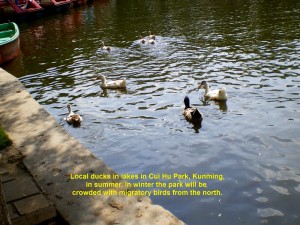
Local ducks in lakes in Cui Hu Park, Kunming, in summer. Migratory birds from the north gather here in large numbers.
Army Military Academy
After an hour of tour of Cui Hu Park, we crossed a busy road to an old dark yellow building which was once an army military academy for local and foreign students. It was founded in 1899 during the Qing Dynasty. After the fall of the dynasty, a new military academy was built to replace the old one.
It had produced many militarists and revolutionists. Now the building is a military museum showcasing the academy history and its achievements. Photos showing military activities in the olden days and military leaders, and some military arsenal relics are displayed in the museum, too.
Later, we went to visit an old temple, Yuantong Buddhist Temple which is not far from the museum.
Yuantong Buddhist Temple
Yuantong Buddhist Temple, located on the southern slope of Yuantong Hill, was built during the Nanzhao period in the late 8th. Century. Having a history of over 1,200 years, it has gone through a lot of reconstruction. Besides, it had changed names a few times. It was during the Yuanyanyou Peiod(1314-1320) that the temple was finally named as Yuantong Temple. Buddhists from far and wide make pilgrimage to this well-known temple.
Yi Liang Zhao Feng Restaurant, Yiliang
After a brief tour of the temple, we left Kunming City and headed 95 km east to a popular tourist destination of a different kind in Yiliang. It is known as Jiuxiang Scenic Spot which is famous for gorges and limestone caves.
On the way to Jiuxiang Scenic Spot, we stopped at a restaurant, Yi Liang Zhao Feng Restaurant, in Yiliang. We entered the restaurant and took our lunch like the way the Yi people usually had their meals. (Yi is a Yunnan ethnic minority.) We sat on low cylindrical-shaped stools round a large low table in a dinning hall. The floor was covered with long, green pine leaves. When food was served on the table we all tucked in and enjoyed the simple but delicious meal.
Jiuxiang Scenic Spot
Then we continued our journey to Jiuxiang. On arrival, we were greeted with some prominent red Chinese characters inscribed on a large rock. They mean that “If you don’t visit Jiuxaing, you need not come to Yunnan”. It implies that tourists should not miss that famous spot.
Jiuxiang Scenic Spot covers an area of 167 sq. km. of highlands, valleys, gorges, rivers, waterfalls and limestone caves. It has six main spots. The spot we visited is the most well-known, i.e. Diehong Bridge Zone.
Yincui Gorge
When we reached Jiuxiang, instead of walking down 300 steps to the bottom of the Yincui Gorge, we took a lift and went down 53 m. The river in the gorge has been raised to a height of over 6m by a dam. On this river, we took a short, slow boat-ride. While boating in the narrow gorge, we marvelled at its steep, rocky slopes.
After the ride, we walked down narrow steps in the steep Yincui Gorge to a large cave. The cave looked like a hall, known as Lion Hall. A concert was held once in that cave. As we went further in, we came across rapids and waterfalls. Besides, we saw some stalactites and stalagmites in a cave that looked like the popular Chinese legendary immortal characters, and the cave is called “Immortals’ Cave”.
Magic or Fairy Field
Walking further into another cave, we saw terraced ponds which looked like a terraced paddy field. That “field” is known as Magic or Fairy Field. When we reached the last cave, we saw lots of bats hanging upside down on its ceiling, and some flying in and out of the cave.
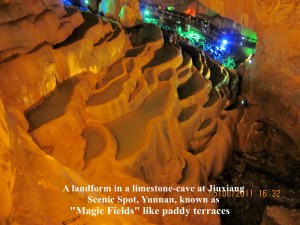
“Magic Fields” that look like terraced paddy fields in a cave of Jiu Xiang Scenic Spot, Yiliang, Yunnan
After going through a series of interconnected cooling and partially lit caves for two hours, we took a cable-chair ride to the place where our bus was waiting. As we had visited so many places in a day on the first day of our Yunnan tour, we felt exhausted. So, after dinner, we checked in and retired early at a downtown hotel known as King World Hotel.
Day 2 Monday, 6th. June 2011
Shilin(Stone Forest)
In the morning, we left Kunming City and headed 83 km east to a place of unusual but stunning landscape. It is a place where lots of tall, grey limestones are standing close to each other. The place looks like a forest. That is why the local people call it “Shilin“ which means “Stone Forest“.
Formation of Stone Forest (Shilin).
According to some geologists, the Stone Forest area was under the sea 260 million years ago. Plants and animals thrived in the sea then. When they died their matters settled on the sea-floor and covered with sediments. Later, under sediment-pressure and high temperature, they became limestone. Subsequently, tectonic plate movement happened and the region was uplifted and became land. Then weathering and erosion took millions of years to sculpture the limestones into the present beautiful shapes.
It was a long journey to Shilin Forest which is 97 km east of Kunming City. On arrival, we were surprised that the place was already crowded with visitors. Swee Poh, our local guide, helped us to explore the stone area for a few hours. We were totally captivated by the stunning and splendid landscape of various shapes and sizes of stones.
As we were walking in the “Stone Forest” we came across a few narrow passages. Some stones had fallen over and others had collapsed due to weathering and earthquake. There were several stones with their top parts fallen onto other stones and resting, dangerously, on them. It was scary to go under these hanging rocks.
While following the trails in the “forest” we saw some stone-structures that looked like animals, e.g. elephants, birds, dragons, etc. The trails criss-cross each other like a maze. Without Swee Poh’s guide, we would have lost our way in that “forest”.
Vantage Point
Finally, Swee Poh brought us to the highest point in the “forest“. It was a pavilion that was built on a rock and commanded a 360 degree view of the “forest” below. We had to climb up steep steps that were crowded with people to reach the pavilion. Standing in the crowded pavilion, we had a breathtaking sight of the forest of stones with some trees growing among them.
Yi Dance
Having spent a few hours enjoying the sights of the unique but strange stones, we stopped for awhile to watch a traditional dance performed by the Yi dancers. In the dance, elderly men were strumming their stringed instruments. They were dancing with a row of women. The dancers were dressed in their traditional costumes of the Yi ethnic minority. A few visitors joined them in their lively dance.
Rainbow Restaurant
Then we left the place for a popular restaurant, Rainbow Restaurant. Our tour-guide told us that there were some shops near the restaurant. According to him, they catered mainly for the domestic tourists, as their things were meant for them.
Tea-Shop
After lunch, we returned to Kunming City. On the way, we stopped at a tea-shop for awhile to learn about some Yunnan tea. It was selling a few kinds of Yunnan tea, like pu-erh, black tea, gold tea, etc. Then some of us bought them for our own consumption, and as presents for our relatives and friends back home.
Tea-Horse Route
Yunnan has been growing tea since over 2,000 years ago. 1,000 years ago, it became well-known for its tea in other regions. Consequently, an ancient tea-route was created to link Yunnan with India via Burma, with Tibet, and with Central China via Sichuan Province. As tea was carried by horses or mules during the ancient days, the route was known as Tea-Horse Route.
“Dynamic Yunnan” Performance at Yunnan Art Theater
In the evening, when we reached Kunming City, we had dinner and then went for a spectacular performance at Yunnan Art Theatre. It was known as “Dynamic Yunnan”.
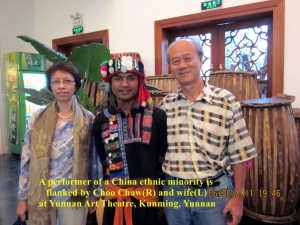
Choo Chaw and wife posing with a performer of a China ethnic minority at Yunnan Art Theatre, Kunming
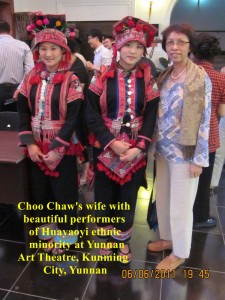
Choo Chaw’s wife posing with two performers of Huayaoyi ethnic minority at Yunnan Art Theatre, Kunming
Yang Liping
A famous Chinese performance artist of 30 years’ experience spent several years searching and training a troupe of over 60 performers from different Yunnan ethnic minorities. She is Yang Liping who has created and choreographed the performance that showcases the Yunnan legends, diverse traditions and cultures, and modern dances too. We watched it for one and a half hour. That energy-charged extravaganza filled us and the rest of the audience with awe all the time.
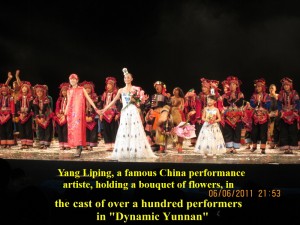
The whole cast including Yang Liping, a famous performance artiste, appearing on stage after the show in Yunnan Art Theatre, Kunming, Yunnan
Day 3 Tuesday, 7 June 2011
Journey to Dali City
At 7.40 a.m. we began our journey to another city, Dali City. It is 240 km west of Kunming City and has a population of over 3.2 millions. The road to Dali City was long, bumpy and dusty. Besides, it was winding and ascending in the first part of the journey. The road went through a few tunnels and an expressway was under construction then. After five hours of bumpy ride and two toilet stops, we arrived at Dali City, safely.
On arrival at Dali City, we were greeted by a lady of Bai ethnic minority, Kim Wah. She was wearing a striking traditional costume. It consisted of a red flowery blouse, pair of white pants with flower-designs and colorful headgear. She brought us straight to a large lake which has a shape of a human ear, and is, therefore, called Erhai(or Ear Sea). We spent a short time at a park by the lake admiring the beautiful scenery of the lake and the mountains, Cangshan, in the distance.
At the park, there is a large, white statue of a beautiful Bai lady. She was supposed to be a fisherman’s daughter.
Cangshan Scenic Spot
Then we went to a mountainous area known as Cangshan Scenic Spot. When we arrived there we took a cable car from Gantong Temple to a height of 2,560 m above sea-level. While ascending in the cable car for a distance of 2,630 m, we had a breathtaking view of the luxuriant Cangshan mountains, V-shaped valleys and Erhai Lake in the distance.
Soon we reached the higher ground and left the cable-cars. Coming out of the station, we saw the world largest Chinese chess board with large concrete “seeds” each weighing 65kg. Each “seed” had a diameter of 1.6 m and thickness 0.5m. The chess board’s length was 21m and width 19m.
Standing on the chess board, I could enjoy looking at the beautiful scenery of the lush-green mountains, a stream, Qingbi Stream, filled with small rocks, pools of turquoise but crystal clear water, V-shaped valleys and Erhai Lake which was far away.
Tianlong Babu Film & TV City
Having spent a few hours in that idyllic place, we descended by cable-cars. Later, we boarded our bus and went to another interesting place nearby.
Located in the centre of the Cangshan-Erhai Scenic Spot, that place was created as a site for shooting movies and TV shows. It was known as Tianlong Babu Film and TV City. It was so named as the first movie that was shot there was “Tianlong Babu”(or “Demigods and Semi-Devils“).
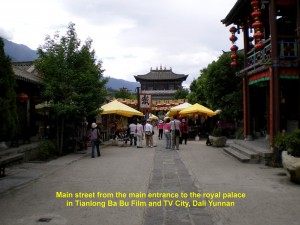
Main street from the main entrance to the Royal Palace in Tianlong Ba Bu Film & TV City, Dali, Yunnan
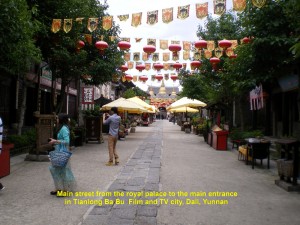
Main street from the Royal Palace to the main entrance in Tianlong Ba Bu Film & TV City, Dali, Yunnan
“Tianlong Ba Bu” Story
“Tianlong Ba Bu” (“Demi-Gods and Semi-Devils”) is a Chinese fiction-novel written by Jin Yong(born in 1924) in 1963-1966. The story is set in the Northern Song Dynasty(960-1127) of China. It is about the “complex, troubled relationships between the great multitude of characters from various empires” including the Liao, Dali, Western Xia and Tibet.
Tianlong Ba Bu Film & TV City Tour
On arrival at the site, my wife and I took a horse-coach ride to tour the place. As we moved along narrow roads, we saw Chinese ancient buildings built, specially, for shooting ancient movies and TV shows. Among them were palace, temple, shops, restaurants, rest-houses and residential houses.
More Photos of Tianlong Ba Bu Film & TV City
Bai Wedding Show
While we were there, we were lucky to watch a Bai wedding show. It was about a rich man who wanted his young, pretty daughter to get marry. So, one day he called all the young eligible bachelors from his village to gather in front of his house. Then his daughter stood on the second floor of his grand house and looked, carefully, for a handsome, young man below. When she spotted one she threw down a red flower-ball to him. He grabbed it and was immediately ushered into the house by the rich man’s servants. He was then dressed like a bridegroom and married the girl.
The picture below shows a girl throwing down a flower-ball:
A Hilarious Wedding Show
But during the actual show, when a girl threw the flower-ball down to a young man, he did not bother to catch it. It just landed a metre in front of him. Nevertheless, two rich man’s servants walked up to him, grabbed him and brought him into the house. All of us, spectators, laughed, loudly, at the way he was handled by the servants. Finally, the man was “forced” to marry the girl. Anyway, the whole show was just an act but we enjoyed watching it.
Ancient Dali City
The next place we visited was the old Dali town. This town, located near Tianlong Babu Film and TV City, is small and was established in the 14th. century during the Ming Dynasty. It was a home to the Bai ethnic minority. Now it is a tourists’ attraction as the town still looks ancient with old architectural buildings, narrow streets paved with stone-slabs and two large ancient gates, North Gate and South Gate.
In the town, the main street of 100 metres long, Fuxing Road, runs from the North Gate to the South Gate. There is a street known as Yangren Street(Westerners’ Street) that has new buildings of ancient Bai architecture. Cafes and western food are sold in some of these buildings.
Other ancient buildings in the town sell goods ranging from souvenirs, clothing, food, beverage to pottery, antiques and silver jewellery. Walking in this old place did give me a feeling that I was living in the olden days.
More Photos in Ancient Dali Town
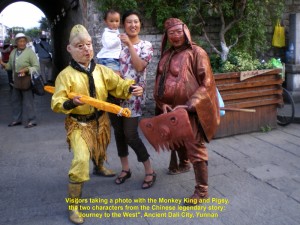
Visitors taking a photo with the Chinese lengendary Monkey King and Pigsy in Ancient Dali Town, Yunnan
Landscape Hotel, Dali
After the tour of the small, charming, quaint Old Dali Town, we went for dinner and checked in at a hotel known as Landscape Hotel. This hotel’s buildings look like the Bai buildings with white walls and grey roofs. There are many plants growing at the hotel. Besides, it has a beautiful courtyard with a pavilion and fish ponds in its compound. Indeed, the hotel lives up to its name, i.e. Landscape Hotel.
(continued on Yunnan Travel II)
Written by Choo Chaw, Kluang, Johor, Malaysia
Yunnan Travel II (Dali, Lijiang)
(continued from Yunnan Travel I)
Yunnan II
(Dali, Lijiang)
Day 4 Wednesday, June 2011
The Landscape Hotel served two types of food: Chinese and Western. As we had been eating Chinese food the last few days in Yunnan, we took a western breakfast for a change at the hotel. Then we left and went to a Bai village.
Bai Village
In the village, we saw Bai houses made of stones. But there was one old, quaint, large double-storey house that was made of wood. It was a showcase of a Bai residence, tradition and culture. We took a quick tour of the house and were treated to different kinds of Bai tea. Later, we watched two cultural shows in the house. One was a Bai fashion show and the other Bai wedding show.
Sa Village
Having learned something about the Bai culture and tradition at the old house, we left for a fishing village, Sa Village, that is by the Erhai Lake. On arrival, we all boarded a metal boat. The boatman with the help of some of us rowed the boat to a deep spot of the lake. Then a show started.
Cormorants
A man in another boat brought our attention to his birds, cormorants. He was holding a long pole with two birds perching on it. Besides, he had several other birds perching on his boat. At his command, the birds jumped into the lake. But, two stubborn birds refused to enter the water. The man had to used his pole to nudge them into the water.
We could see all the birds swimming, ecstatically, in the water. But, when the man shouted at the birds, they all dived into the water looking for fish. A few minutes later, one of them caught a large one and brought it to the surface for the owner. Later, another large fish was caught, and it was caught by three birds. The owner took the fish and rewarded all the birds with small fish he kept in his boat. One of our tour-members bought one of the fish for RMB 60 and the other fish was bought by a tourist in another boat. Later, we were brought to a lakeside where a Bai lady fried the fish for us.
Dwindling Number of Cormorants
According to a Bai lady on the lakeside, using birds to catch fish is not a common practice anymore, as young Bai people prefer to go to cities to look for more stable jobs. As a result, the number of cormorants has dwindled to less than 100, and they are now used for showing tourists their skill in catching fish in the lake.
Soon, we left Sa Village, and went to the old Dali Town to have lunch. In the afternoon, we left Dali and went north to Lijiang City in the higher mountainous area.
Black Dragon Pool Park, Lijiang
After three hours of safe but tiring journey, we reached Lijiang City which has a population of over 1.1 millions. In the city, a local guide, Lee, welcomed us. He brought us to an old, small but beautiful park, Black Dragon Pool Park.
Black Dragon Pool Park is a tourist attraction. It has a small lake, Black Dragon Pool(Heilongtan), surrounded by shady trees and well-kept gardens. An ancient Chinese marble bridge, Five-Arch Bridge, can be seen across the lake in the middle. Besides, some ancient buildings are found at the park, e.g. Moon-Embracing Pavilion or Deyue Lou(built in the late Qing Dynasty but it was rebuilt in 1963), Dragon God Temple or Longshen Temple(built by Naxi people in 1737) and Five-Phoenix Tower or Wufeng Tower(built in 1601 but moved there from Fuguo Temple, 30 km away, in 1979)
Old Lijiang Town
After going round the tranquil and romantic park once, we left for the Old Lijiang Town of 800 years old. In 1977, it was declared as a UNESCO world cultural heritage site. It is now a popular tourist destination.
Flowing through the town are three streams: East Stream, Middle Stream and West Stream. They originate from the main river, Yuhe River(Jade River) which flows from the Black Dragon Pool in the north of the town. Large colorful fish can be seen swimming in them.
The old Lijiang town has over 3,000 ancient Chinese wooden buildings. They are built, closely, along the streams and streets paved with stone-slabs. These buildings are now shops selling all kinds of local products that tourists might be interested in, and bars with red lanterns hanging outside them.
Located in the centre of the town is a small square where four streets converge. It was once a busy trading place for tea, and a busy market for the local residents.
Wooden Water-Wheels
When we arrived at the Lijiang old town in the evening, the first thing that attracted our attention was the twin large, wooden water-wheels. The Jade River kept them turning, continuously. Many tourists, including myself, liked to take photos with the wheels as a background. We noticed that the popular old town was crowded with tourists.
We spent a few hours browsing the shops, watching people dancing in a large circle in an open space(Yuhe Square), and looking at the quaint buildings of ancient architecture of the Naxi ethnic minority.
Later, we left the place and checked in and retired for the night at a nearby hotel known as Puruiduom Holiday Hotel.
Day 5 Thursday 9, June 2011
Naxi Village in Dongba Valley
In the morning, we traveled to a Naxi village in Dongba Valley which is 15 km north of Lijiang City. (Naxi is an ethnic minority.) That place was thronged with tourists. We joined them to learn about the Naxi people’s tradition, culture and religion.
When we entered the village, we saw small stalls on both sides of a path. The stall-keepers were ladies dressed in Naxi traditional costumes. They were selling arts, handicrafts, food, drinks, souvenirs, traditional clothes, etc. The path led to some Naxi houses, e.g. Taliu’s and Pumi’s. The houses were simple and made of logs. No modern gadgets, like TV, gas-cookers, refrigerators, etc. were seen inside those houses.
Naxi’s Gods
In one of the houses lived a Naxi priest. The Naxi people worship many kinds of gods(over 2,000 of them), including the God of Nature. They believe that all the gods can bless them with good luck, happiness and good harvests. Besides, the people believe that the gods can get rid of ghosts, like evils or monsters, that can harm their lives.
A Horror Demonstration
In a dark room in another house, we watched a middle-aged man showing off his scary prowess. He used his right foot to step on a red hot iron spade and then his tongue to lick it. His act shocked all of us, as the temperature of the metal spade was over 1,000 degrees Celsius. He would repeat that horror demonstration whenever a new group of tourists entered the room. According to a local guide, he had done that since he was a boy. (I will not recommend anybody to watch that performance if he has a faint heart.)
In an open space, a young man was seen climbing up and down a tall ladder with sharp swords as its rungs(sword ladder). He could do it, easily, without his soles getting cut. He was an amazing person.
Lovers’ Room or Youth Cabin
There was an interesting room in a Taliu house. According to the Taliu’s custom, if a girl wants to look for a future husband she will, secretly, invite a boy to a room(Lovers’ Room or Youth Cabin) provided for her to talk about love. She can do this on different nights with different boys until she gets the right one to marry. This is quite an unusual way of allowing a young girl to date a young boy in a room in the absence of their parents.
After seeing all the activities and learning about the Naxi’s tradition, culture and religion in the village, we went to a popular scenic spot, Yulong Snow Mountain. It is not far from the village.
Yulong Snow Mountain
Yulong Snow Mountain is very important to the Naxi people. They consider it a sacred place and call it Wulu which means Silver Rock. The mountain has 13 steep peaks that are over 5,000 m in height. The highest peak is 5596m above sea-level. As the combination of the peaks looks like a large flying dragon from a distance, the Naxi people call the mountain, Yulong Mountain(Jade Dragon Mountain). They also call it Black and White Mountain because of its colours.
Yun Shan Plateau
While we were on our way to a cable-car station, we saw the mountain not very far away, but it was partly covered by clouds. Then we took a cable-car to a higher ground, Yun Shan Plateau, which is over 3,000m above sea-level. Coming out of the station, we walked on a wooden path which cut across the plateau of pine trees to a small grassland.
Disappointment
Thirty minutes later we reached the grassland. There were many tourists on the edge of the grassland. We joined them and hoped to see the Yulong Snow Mountain at close range. But, unfortunately, the mountain was completely covered with clouds then. We stayed around for awhile hoping that the clouds would disappear.
Several minutes had passed, but the stubborn clouds were still covering the mountain. As we could not wait for the whole day, we left the place with great disappointment. We walked back, took a cable-car and descended to the lower cable-car station.
Baishui River(White Water River)
Outside the station, we took a 12-seater car to a river known as Baishui River(White Water River). The river was wide and shallow, and its water was crystal clear and cold. It was flowing from the Yulong Snow Mountain and other mountains. From the river we saw a spectacular view of the landscape of the partially cloud-covered Yulong Snow Mountain, the pine tree-covered mountain-slopes and the river.
Walking further down the river, I was surprised to see the river flowing into terraced ponds which looked lake paddy-terraces. It was a splendid sight with the ponds added to the landscape.
Yaks
While we were enjoying the scenery, we saw some large yaks with colorful saddles on the river side and in the shallow river. These animals are tame oxen with long curved horns and hair, They are used by their owners to help them to earn some extra money. For a small fee, a tourist can ride a yak to the middle of the shallow river and back.
As we had been told by our local guide about the risk of riding a yak, none of us in our tour group wanted to ride one. We feared that tiny creatures hiding in its long hair might crawl into our groins and cause a terrible itch.
V.I.P. Restaurant
Later, we left the place and traveled south to another place, Jade Water Village. On arrival, we had lunch at a restaurant, V.I.P. Restaurant. As the restaurant was on a high ground, we could see the wide and long Dongba Valley where the Naxi people have been staying for many generations.
Yushui Xiang(Jade Water Village)
After lunch, we entered the Jade Water Village(Yu Shui Village)which is next to the restaurant to learn about the Naxi people’s tradition, culture and religion. In the village, there is a prominent, shining, tall, golden statue of the God of Nature. The Naxi people worship Him for good harvests, peace, harmony, luck, happiness, etc. In return, they promise Him to protect Nature’s forests, animals, plants, etc. and keep the environment clean. Their religion is known as Naxism or Dongba religion.
In the village, there are other attractions, like clean ponds with salmons, Dongba Museum, Calligraphy and Painting Institute, Naxi Ancient Village, Wine and paper workshops, etc.
After a tour of the quiet place, we travelled back to Dali City. On arrival, we had dinner, and then visited the old Dali town again hoping to buy something for ourselves, loved ones and friends. At night we stayed at the magnificent Landscape Hotel, the same hotel we put up two days ago.
(continued on Yunnan Travel III)
Written by Choo Chaw, Kluang, Johor, Malaysia
Yunnan Travel III (Kunming City)
(continued from Yunnan Travel II)
Yunnan Travel III
(Kunming City)
Day 6 Friday, June 2011
Travelling Back to Kunming City
At 8 in the morning, we travelled from Dali City back to Kunming City. After over four hours of sitting in the moving bus and rocking inside whenever it travelled on bad roads, we, finally, reached the city. We, immediately, went to a restaurant for a late lunch.
Xishan Scenic Spot(West Hill Scenic Spot)
After lunch, we went to a famous Yunnan tourists’ spot, Xishan Scenic Spot(West Hill Scenic Spot). Located close to the Dianchi Lake and 15 km from Kunming City, this lush-green mountainous area has some places of interest to visit. But the only place our local tour-guide, Swee Poh, thought it was worth visiting was the Dragon Gate. He told us that some Chinese leaders had visited that spot, like Zou Enlai, Liu Shoqi, Jiang Zemin and Zho Rongji. Besides, foreign dignitaries, like Queen Elizabeth(Britain), Henry Kissinger(ex-Secretary of State of USA) and Helmut Kohl(ex-Chancellor of West Germany), had visited the place too.
On arrival at the scenic spot by our tour bus, we hopped onto a 10-seater car and went straight to the entrance to Dragon Gate near the Taoist Sanqing Pavilion. Starting from the entrance, we climbed a long flight of stairs to the Dragon Gate.
The flight of stone-stairs is built on the steep slope of the Xishan Hill(Western Hill). Along the flight, there are some interesting things to see, such as the breathtaking view of the large Dianchi Lake, Kunming City in the distance and temples along the way.
Dianchi Lake
Dianchi Lake which is at the foot of Xishan Hill covers an area of 200 sq. km. Shaped like a crescent, it is 39 km long and 13 km wide at the broadest. Over 20 rivers from the surrounding mountains flow into the lake. It is the largest freshwater lake in Yunnan and the 6th. in China.
Temples
Among the temples along the flight of stairs are Sanqing Pavilion, Lingguan Pavilion, Doumn Taoist Pavilion, Hall of the Divine Parents and Daitian Pavilion. But the most important thing that all the tourists want to see at the scenic spot is the little, simple arch known as Dragon Gate. It is located at 2300m above sea-level and 300m above Dianchi Lake. Most of these structures were constructed during the Ming and Qing Dynasties.
As we went up the crowded stairs, we stopped at some of the temples to find out the kinds of deities that were worshipped. We also stopped at different heights to see the stunning scenery of the Dianchi Lake and the city.
God of Fortune
In the middle of the climb to the Dragon Gate, there is a dark red statute of a fierce-looking deity holding a golden egg in his left hand and a sword in his right hand. Besides, he is stepping on the head of his carnivorous pet with his right foot. Two Chinese characters are written on his tummy that say he is the God of Fortune.
According to our tour-guide, Swee Poh, this deity may give you wealth if you can jump and touch his golden egg. While I was there, I watched with amusement some tourists trying their luck. As the God of Fortune was standing on a rock, many failed to reach it. Those who failed would touch his pet’s nose hoping that it would give them wealth instead.
Dragon Gate
After less than an hour of slow climbing and occasional, accidental jostling against some people on the crowded steps, we, finally, reached a spot where we could see the Dragon Gate that was 200m further up on a cliff. To reach that structure, we had to climb narrow, steep steps through a small but short tunnel, Yunhua Cave.
According to the information given there, there was a diligent Taoist monk who took 14 years(1781-1795) to cut a path and tunnel(Yunhua Cave) on the cliff from the Phoenix Rock to Dragon Gate and another tunnel(Ciyun Cave) higher up. The person who risked his life doing that on the cliff of Xishan Hill(West Hill) was Wu Laiqing.
The Dragon Gate is a well-known small, low arch of height about 2m and width 1m. Just below the arch is a “dragon ball“. Lots of people like to touch it, as they believe that the “dragon” will bring them riches. Adjacent to it is a small temple, Daitian Temple which houses three divine deities.
Spectacular Panoramic View
When we reached the Dragon Gate, we felt a sense of achievement in climbing up so high. Standing on a platform near the Dragon Gate, we got a spectacular panoramic view of the large lake and the city. But when I looked down below it, I could not see the slope of the hill. Then I wondered how the people in the olden days managed to build such a platform on the vertical slope of the hill.
A moment later, we saw heavy rainfall over Kunming City in the north. As we had seen enough of the place, we descended the hill. When we reached the bottom, we were caught in a heavy downpour. A few minutes later when it stopped, we went back to our bus. It then took us to a Chinese medicine shop in the city. In the shop we were introduced to some “miracle cure” medicines. Two of our tour-members bought some of them. Later, we checked in at Yunnan King World International Hotel where we had our dinner and retired for the night.
Day 7 11. June 2011
Day 7 was the last day of our tour in Yunnan. Our local tour guide would bring us to shopping malls in the Kunming City centre to buy something to bring back home.
Jinma Biji Square
But before we went shopping, Swee Poh brought us to a popular place known as Jinma Biji Square(Golden Horse and Jade Rooster Square) located along Jinbi Road in the city centre. In that square, there are two beautiful, large, similar arches, measuring 12 m high and 18 m wide. One of them is known as Jinma(Golden Horse) Arch and the other Biji(Jade Rooster) Arch. These arches are over 100m apart. They were recently built to replace the old ones which were destroyed during the China Cultural Revolution in the 1960’s. The arches look majestic, exquisite and very ancient. They have become one of the Kunming City’s iconic landmarks.
Shopping Malls
Having spent sometime in the square, we crossed Jinbi Road and entered an area of some large shopping malls, like Brilliant Plaza, Splendid Plaza, Yilong Building, etc. These malls are located along Bu Hang Road between Jinbi Road and Tong Fong Xi Road selling branded goods. In this shopping area, there is a large arch which is similar to the two in the Jinma Biji Square. It is known as Zhongai(Faithful Love) Arch.
Bu Hang Road is closed to the traffic and has become a pedestrian walkway with a few rows of shady trees growing in the middle. While we were there we saw five men, each holding a big notice-board telling the public that a person was very sick and required donation for large medical expenses. Many sympathizers donated money which they put into a red tin placed in front of them. My wife and I were touched by the plight of the sick and donated some money, too.
Back Massage by a Blind Man
We spent much time window-shopping inside some malls and browsing some roadside stalls, too. Then we went for a back massage under the trees. My masseur was an elderly blind man, Mr. Chou, who had been in that profession for 30 years. He had done a good job even though he had given me a few painful rubs on my back, shoulders and arms.
Later, we left the shopping centre for lunch at the Weilong Hotel restaurant nearby. After lunch we visited a few more places, e.g. a large shop selling all kinds of herbs for health and diseases, a silk factory selling quilt and other silk products and a coffee museum. Then it was time to go back to our country, Malaysia.
Departure
After dinner, we went to the Kunming Airport which was near the city and bade farewell to our local guide, Swee Poh, and tour bus-driver, See. At 11 p.m. (local time), we departed Kunming and flew straight back to Singapore Airport. Less than four hours later, we arrived at the airport where our tour company’s bus brought us back to our respective hometowns.
Well, that was our 7-day tour in Yunnan, another successful and memorable one which I am glad to add to my long list of travels.
Thank you for reading this travel and hope you have gained some information from it. If you have gone there before, I hope this has taken you down memory lane.
Acknowledgement
Here, I would like to thank the tour company, Vacation Hub Travel & Tours Sdn. Bhd., for arranging the interesting tour, its helpful employee, Vin Ng, for showing us a preview of Yunnan tourists’ destinations, its cool, caring and efficient employee, Kent Tay(the tour leader), the Kunming careful and super driver, See, and, lastly but not least, the three diligent China tour guides, Swee Poh(Kunming), Kim Wah(Dali), and Lee(Lijiang).
The End
Written by Choo Chaw, Kluang, Johor, Malaysia
Macau Travel
Geography of Macau
Location Macau is in the south-east of China. Located on the west bank of the Pearl River close to its river mouth and 60 km west of Hong Kong, it consists of four parts: a peninsula (Macau), two islands (Taipa, and Coloane) and a reclaimed land (Cotai) which joins the two islands. Taipa island is linked to the peninsula by three long bridges, viz. Friendship Bridge, Macau-Taipa Bridge and Sai Van Bridge.
Population Macau is a tiny territory of 28.2 sq. km. and has a population of about half a million. About 95% of the population is Chinese and the rest Portuguese and other races. Although they belong to different races and practise different religions, traditions and customs, they have co-existed, harmoniously, for many centuries.
Although Chinese and Portuguese are the official languages Cantonese is widely spoken here. English is usually used in trade, tourism and commerce.
Tourism Tourism and gaming industries are the mainstays of its economy. Other industries that contribute, significantly, to its economy are apparels, textiles, electronics, footwear and toys.
Macau is a paradise for night-birds, locals and foreign alike, as it has lots of bars, pubs, karaoke clubs, discos, shops and restaurants as well as casinos that are open all night long.
Transport The common public transport is bus. Scooters are popular vehicles in Macau streets. Trishaws are a common sight in the east of Macau City. They carry tourists for city-sightseeing. There are no trains in Macau.
Most of the names of the roads are in Portuguese and, surprisingly, long. If you do not know Portuguese, it will be difficult for you to pronounce and remember them.
History of Macau
The Arrival of the first European, the Portuguese Before the arrival of the first European, the Portuguese, in the 1550’s, Macau was already a busy Chinese trading port. When the Portuguese came, they established a trading post and later many made it their home.
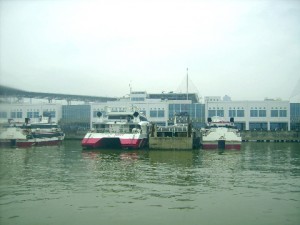
1557 – 1999 Period
In 1557, China allowed Portugal to administer Macau. More than four centuries later, on December 20, 1999, the latter returned the territory to China. Since then Macau has become China’s second Special Administrative Region (SAR) after Hong Kong. It is allowed to enjoy autonomy in all matters except foreign and defence affairs until 2049. On July 16, 2005, ‘The Historic Macau Centre’ was declared as a UNESCO World Heritage Site as it has many architectural legacies, like churches, temples, mansions, fortresses, quaint government buildings and public squares.
Itinerary of Macau Tour
After a three-day tour of Hong Kong my wife and I left Hong Kong for Macau by ferry on 3 May 2007. The ferry ride was rough as the sea was choppy. On arrival at Macau Ferry Terminal, my wife had a slight feeling of nausea. As she could go on we took Bus No. 3 to Macau downtown and checked in at a budget hotel in a street, Rua da Felicidade. Then we left the hotel and began a sightseeing tour of Macau City, immediately.
Below is the itinerary of our memorable Macau tour on 3 May 2007.
1 Macau Roads
2 Senado Square / Holy House of Mercy / Macau Government Tourist Office / St. Dominic’s Church
3 Ruins of St. Paul’s / Crypt and Museum of Sacred Art / Na Tcha Temple
4 Mount Fortress / Macau Sky Tower / Museum of Macau
5 St. Michael’s Chapel / Lou Lim Ieoc Garden / Casinos
6 Macau Fisherman’s Wharf
7 Travel Back to Malaysia
3 May 2007:
Rua da Felicidade (Happiness Road) After checking in at a budget hotel in Rua da Felicidade (Happiness Road), we walked along the road and noticed the old buldings on both sides of the road are small and old. They look like those we saw in Jonker Street in Malacca (Malaysia). Incidentally, Malacca was once a Portuguese territory too. A few of these buildings have become budget hotels for backpackers and restaurants.
Cookie Shop In the same street, there are many shops making and
selling Chinese pastries or cookies, such as almond cakes, egg rolls and cashew-nut cookies as well as red, sweet BBQ thin slices of meat. These cookies shops can also be found in other streets in the Macau Downtown. When we stopped at a shop, a lady-owner generously gave us some small pieces of cookies to try. After tasting a few, we found that we liked the almond cookies the most. They melted slowly in our mouths and the small pieces of almond nuts in them were fresh and crunchy. So my wife bought several boxes of them as presents for our relatives and friends back home in Malaysia.
Avenida Almeida Ribeiro Later, we were in the busiest street in
the city, Avenida Almeida Ribeiro. It is like Orchard Road in Singapore or Nathan Road in Hong Kong. It is difficult to walk on the crowded five-foot ways in the street without being knocked or knocking on somebody, accidentally. On one occasion, I accidentally knocked a man and apologized to him. But he just walked on. I guess it is a common incident in any crowded place and everybody tolerates it.
This street is a tourists’ shopping paradise. Shops sell all kinds of goods like electrical and electronic items, mobile phones,
jewellery, curios, apparels, antiques, traditional Chinese foodstuffs, herbs and medicine, fast food, local and exotic cuisine, watches and Chinese cookies.
Along this road, besides tall, modern buildings, some large quaint ones of fine architectural designs can be seen. A few fine examples are the one that houses the General Post Office, another a bank, China Construction Bank, and another also a bank, Banco Nasional Ultramarino.
Senado Square (Largo do Senado) Near the General Post Office is Macau’s most famous public square known as Senado Square. It is one of the eight squares in Macau. The rest are Barra, Lilau, St. Augustine, Cathedral, St. Dominic, Company of Jesuits and Camoes. Senado Square is surrounded by pastel-coloured neo-classical buildings, creating a Mediterranean ambience. Holy House of Mercy,
the Macau Government Tourist Office and St. Dominic’s Church are some of the quaint buildings located there. The Square has been used for public events and celebrations for centuries. Lots of tourists and locals alike like to visit this beautiful place.
Holy House of Mercy (Santa Casa da Misericordia) This neo-classical style building was founded by the first Bishop of Macau in 1569. It was an institution for western-style medical clinic and other social structures. It is the only white building at Senado Square.
A Museum The House of Mercy houses a museum that was opened in 2001. Its exhibits feature the history of the House itself as well as Macau. They include paintings, manuscripts, a bronze
bell, ivory statues, religious artefacts and Chinese, Japanese and European porcelain pieces.
The Macau Government Tourist Office Opposite Holy House of Mercy is a three-storey yellow building which houses the Macau Government Tourist Office. Free consumer brochures, maps, guidebooks and shopping guidebooks are available here. These are also available at the Ferry Terminal, Airport Arrival Hall, Guia Lighthouse and other places. They provide useful information for tourists like us.
St. Dominic’s Church (Igreja de S. Domingos) Next to the Macau Government Tourist Office is a well-known church, St. Dominic’s Church. This church was built by three Spanish Domincan priests from Mexico in 1587. Its stone facade is yellowish and has white stucco and green-shutted windows.
Inside the church is an altar that has a white statue of Virgin Mary and Child and a painting of Jesus Christ. Some carved ivory and wood saints can be seen inside too.
The Church’s Past History In the past, St. Dominic’s Church had a few violent and dramatic incidents. In 1644, a military Portuguese officer who was a traitor was murdered at the altar during Mass. Then in 1707, the local soldiers tried to enforce an excommunication order on the Dominican friars for supporting the Pope against the Macau’s bishop in the Rites Controversy. But the latter locked themselves in the church for three days, throwing stones at the soldiers. In 1834, when the monastic orders were crushed, the Macau government used the church as a barrack, stable and public works office for a time.
First Portuguese Newspaper It was in this church that the first Portuguese newspaper, A Abelha da China (The China Bee), in the east was printed on 12 September 1822.
There is a museum from the 1st. to 3rd. floor in the church, exhibiting paintings, sculptures and liturgical objects that depict the rich history of the Roman Catholic Church in Asia. It is opened to public since 1997.
Opposite St. Dominic’s Church is a quaint, yellow four-storey building. Its architectural design is similar to the one that houses the Macau Government Tourist Office. It is now a popular place for food lovers who have a choice to savour Chinese cuisine at Chua Lam Gourmet Kitchen or western fast-food at Mcdonalds.
Ruins of St. Paul’s (Ruinas de S. Paulo)
While we were walking on a narrow road, Rua de S. Paulo, from Senado Square to the Ruins of St. Paul’s, we were amazed to see the road crowded with tourists: some going up to the Ruins of St. Paul’s, some coming down to the Senado Square and others stopping by to shop. When we reached the Ruins of Paul’s, we were awestruck to see it still standing majestically on a high ground. This stone facade is all that is left after a church, the Church of Mater Dei (Mother of God), was burnt down in 1835.
The Jesuits The church was built by the Jesuits (members of the Society of Jesus) in 1602-1640. The monumental ruins is now Macau’s icon.
If one stands in front of the magnificent facade and looks closely, one will see carvings and small figures on it. It has statues of Virgin Mary and saints, symbols of the Garden of Eden and the Crucifixion, angels and the devil, a Chinese dragon and a Japanese chrysanthemum, a Portuguese ship and pious warnings in Chinese.
We went behind the facade, climbed up a steel staircase, stood on a high platform, looked through one of the windows in the facade and were captivated by a panoramic view of the Macau Historic Centre below.
The Crypt and Museum of Sacred Art Located behind the
facade is the Crypt where the remains of the martyrs of Japan and Vietnam in urns are displayed. Adjacent to it is a museum, Museum of Sacred Art, where one can see exhibits of paintings, sculptures and liturgical objects of the churches and monasteries of Macau from the 16th. to the 19th. century. These exhibits are testimony to the rich historical past of the active Christian missions in Macau and the Far East.
Na Tcha Temple (Templo de Na Tcha) When we came out of the Ruins of St. Paul’s, we were surprised to see a small Chinese
traditional temple, Na Tcha Temple, on the right-hand side of the Ruins. It was built for a child deity in 1888 by the Chinese who prayed to him for help to contain the plague then. I saw some devotees praying inside. They could be asking the deity for happiness, peace, harmony, prosperity, good health or help to solve their personal problems.
Mount Fortress / Monte Fort (Fortaleza do Monte) We left the Ruins of St. Paul’s and walked up a few fights of steps to a fort, Mount Fortress, nearby. It is a large fortress on the highest hill in the Macau city. It was built
in a trapezoid shape in 1617-1626 and was armed with large cannons pointing in all directions to protect the city in the olden days. Some cannons made in 1860 can be seen on top of the fort and are now a tourist attraction.
A Panoramic View of the Macau City From the top of the fort we had a spectacular panoramic view of the Macau city. We saw many city landmarks such as the Sky Tower in the distance, hospital, high-rise commercial, residential and historical buildings, and churches. Tall buildings are built in the city as land is scarce there.
Macau Sky Tower This tower looks like the one I saw in Auckland in New Zealand in 2003. Its height of about 338 metres is 10 metres shorter than the Auckland Sky Tower. The tower is used for telecommunication and broadcasting and is opened to public since December 19, 2001. It is a popular tourist attraction as it has an observation deck with panoramic views, restaurants, theatres, shopping malls and the skywalk. The skywalk is not for the faint-hearted as the walk is round the outer rim of the tower, 233 metres above the ground. For the thrill-seekers, they can jump off the rim while they are being tethered with a long elastic rope. This is like a
bungee jump. If you have watched an episode in a reality show ‘The Amazing Race: All Stars‘, this tower was used as a roadblock requiring the competitors to do the bungee jump.
Museum of Macau Mount Fortress has a museum known as Museum of Macau. It has three floors of exhibits. The exhibits on the first floor show the historical past of Macau. On the second floor are exhibits that feature different aspects of popular art and traditions of Macau and the third floor shows the modern Macau city.
Chapel of St. Michael After visiting Mount Fortress and Museum of Macau, we walked to Lou Lim Ieoc Garden. On the way, we came across a small green chapel with white stucco and stained glass windows built in a Catholic cemetery. It is known as Chapel of St. Michael and was built in 1875.
Lou Lim Ieoc Garden When we entered Lou Lim Ieoc Garden, we thought it was a beautiful Chinese garden. It is built in the classic Suzhou style with a landscape of flowers, bamboos, rocks, a lake teemed with fish and tortoises and tall plants. It is shady and a
pleasant place to relax and enjoy its charm and beauty. Besides, it has a pavilion, moon gates, a colourful Chinese mural on a wall, an old Chinese house and another new but bigger one, creating an atmosphere of an imperial Chinese garden. Undoubtedly, many local senior citizens like to spend their time there making it as their retreat. When we were in the garden, we saw many of them doing light exercises, playing Chinese chess, catching up on each other’s news and relaxing.
When we entered the new building we were lucky to see an exhibition of Chinese paintings of and calligraphy of a local artist, Gao Lijie (Gao Yin). His 46 exhibits feature animals, human portraits, flowers and landscapes. It was quite an impressive exhibition.
Sands Casino Later, we left Lou Lim Ieoc Garden and took a taxi to Sands Casino. Sands is one of the 28 casinos in Macau. The others are Lisboa, Mandarin Oriental, Fortuna, Galaxy, Rio, President, Babylon, StarWorld, Marina, Grand Waldo, Emperor Palace and Golden Dragon to name a few. Among all the Macau casinos, Sands is the largest so far. It has four floors of many kinds of gambling, like slot
machines, roulettes, dice and card games. A new Macau casino will be ready in August 2007. It is located on a reclaimed land known as Cotai Strip between Taipa Island and Coloane Island. The new casino, The Venetian, will be the largest in Asia and the second in the world.
A Crowded Casino Before entering Sands Casino, we were thoroughly checked for weapons by its security guards. We were not allowed to bring in bottled drinks as they feared that they might be inflammable liquids. When we were inside Sands Casino we were
amazed to see lots of people gambling on all the flours. I noticed most of the gamblers were from Mainland China and Hong Kong. After spending a short time at the casino watching some of them gamble, we headed for a large theme park, Macau Fisherman’s Wharf, which is on the waterfront nearby.
Macau Fisherman’s Wharf At this theme park, there is a 40-metre high man-made black volcano. It belches out smoke and fire with a loud explosion, frequently. It is in an area where there is fun and excitement for children at ‘Vulcania’, ‘Aladdin’s Fort’ and ‘The Underground Amusement Center’.
An International Atmosphere The theme park is unique as it
has many kinds of buildings of different architectural styles, creating an international atmosphere. Each building is given a name of a well-known place where it has the same type of buildings or a famous building that looks similar, like Roman Amphitheatre, Rome, Palace, Italian Riveria, Trinidah, Havana, Amsterdam, Mississippi, New Orleans, Tang Dynasty and Potala Palace. These buildings house restaurants serving local and exotic cuisines, shops selling goods ranging from souvenirs to jewellery, bars, cafes and many more.
At this park, gamblers can try their luck at a large beautiful casino, Babylon, or Flamingo Slot Club which has 285 slot machines. Visitors can stay at a Victorian-style hotel, Rocks Hotel. They may visit a bank which is adjacent to the casino. Since the park has so many facilities, it can be a township itself.
As the park covers a large area (111,500 sq. m.), visitors can hop on to small tour-buses for a free ride.
After visiting a few interesting places in Macau in one day, we went back to our budget hotel.
4 May 2007 Travel Back To Malaysia
On the following morning of 4 May 2007, we left our hotel in the Macau downtown and travelled to Macau Airport. Before entering the immigration checkpoint, we had to leave our drinking bottles behind as they exceeded 100 ml. (Most international airports in the world are now disallowing passengers to carry more than 100 ml. of liquid, gel or cream in a container for security reasons.)
Later, we boarded an Air Asia plane and flew back to our country, Malaysia, bringing along with us fond and memorable memories of the Macau tour as well as the Hong Kong tour. The smooth flight took 3 hrs. and 40 mins.
That’s all about my Macau travel. I hope the information is useful to you.
Written by Choo Chaw, Kl;uang, Johor, Malaysia
Hong Kong Travel / Home / Shenzhen, Hezhou, Quilin, Zhaoqing Travel

